- Types of Sailboats
- Parts of a Sailboat
- Cruising Boats
- Small Sailboats
- Design Basics
- Sailboats under 30'
- Sailboats 30'-35
- Sailboats 35'-40'
- Sailboats 40'-45'
- Sailboats 45'-50'
- Sailboats 50'-55'
- Sailboats over 55'
- Masts & Spars
- Knots, Bends & Hitches
- The 12v Energy Equation
- Electronics & Instrumentation
- Build Your Own Boat
- Buying a Used Boat
- Choosing Accessories
- Living on a Boat
- Cruising Offshore
- Sailing in the Caribbean
- Anchoring Skills
- Sailing Authors & Their Writings
- Mary's Journal
- Nautical Terms
- Cruising Sailboats for Sale
- List your Boat for Sale Here!
- Used Sailing Equipment for Sale
- Sell Your Unwanted Gear
- Sailing eBooks: Download them here!
- Your Sailboats
- Your Sailing Stories
- Your Fishing Stories
- Advertising
- What's New?
- Chartering a Sailboat

How to Build a Boat
If you want to know how to build a boat you've come to the right place, because that's what we did, learning as we went. She's called Alacazam , and you can see her in action in the picture above, charging through the Caribbean Sea off Montserrat. And we're going to take you through the entire sailboat construction process...
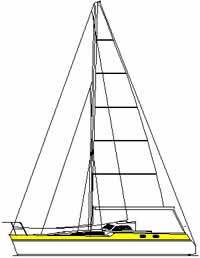
Jumping forward several years...
She was called 'Alacazam' , from the great Nat King Cole's song Orange Coloured Sky, and these are her vital statistics...
- Length overall: 11.5m (37.5 feet)
- Waterline length: 10.6m (34.5 feet)
- Beam: 3.9m (12.5 feet)
- Draft: 2.2m (7 feet)
- Displacement: 7,023kg (7.75 tons)
- Displacement/length ratio: 159
- Sail area/displacement ratio: 18.28
Of course you don't have to start from scratch as we did; there are a few other boat building options available that could save time and maybe cash too.
Whichever option you choose it's a very good idea to think the whole project through from beginning to end, as nothing can cause more disruption and additional cost than changing your mind halfway through a boat construction project.
It's an inescapable fact that cost and size are closely related, but not in a linear fashion as you might assume. If you double the length of the boat you're likely to increase the costs by a factor of four; and not just the build costs, but owning and operating costs too. Just wait until anti-fouling time comes around and you'll see what I mean.
Berthing costs seem to take a hike at around 12m (40ft) overall, and another at 15m (50ft), which was the final compelling factor in sizing our self-build cruising sailboat at 11.5m (38ft) on deck. This allowed for the anchor poking out at one end and the self-steering gear at the other, just in case any marina employee should get overzealous with the tape measure.
But where do you want to start? Here are your three main options:
- Buy an old, tired boat and completely refurbish her, or
- Buy a bare hull and deck moulding for home completion, or
- Start from scratch, and build the hull yourself.
We'll take a look at these three options in turn:
1. Starting With a 'Fixer-Up'
This can be a great option, particularly if you can get your hands on an old but tired pedigree boat with a proven reputation like the Ted Brewer designed Morgan 28 shown here - and you might just get it at an absolute knockdown price.
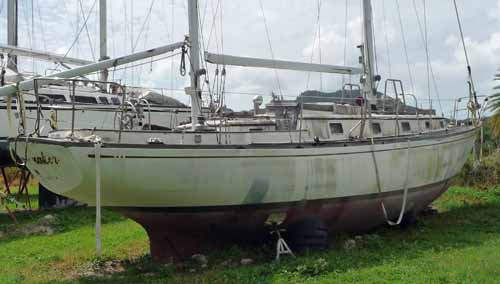
With luck, much of the interior will be salvageable, but you'll probably want to bring the instruments and electronics up to date, replace the rig and all the rigging, install a new engine and stern gear and replace the hatches and much of the deck equipment.
But you really should get a professional surveyor involved before you take up such a project. Explain to him carefully what your intentions are, and ask him to prepare his report with that in mind; it could save you a whole heap of time and money.
2. Starting from a Bare GRP Hull
This approach will get you off to a flying start, particularly if the hull comes with the deck moulding already fitted and the bulkheads bonded in. The problem will be in finding one, as few manufacturers seem to offer this once popular option these days.
3. Starting from Scratch
You need to take a very deep breath before setting off along this route - and believe me, I know, because this is how we built our custom designed sailboat Alacazam .
Unless you're building from an established set of boat plans, you'll be well advised to get a yacht designer involved at the outset.
And one of your first decisions will be the choice of hull material - fibreglass, steel, aluminium, ferro-concrete or wood - but which one, and why?
The Outline Requirements for our 'Ideal Cruising Sailboat'
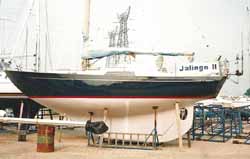
My current boat at the time was a Nicholson 32 Mk10. Jalingo was a narrow hulled, heavy displacement, long keeled cruiser that I'd sailed thousands of miles - much of it singled handed (until I met Mary, who put paid to all of that self indulgence) - off the shores of the UK, France, Spain and Portugal, and to the Mediterranean and back.
Her hull shape and displacement ( Jalingo's , not Mary's) meant that she was comfortable in a seaway and great in a blow, but sluggish in light winds - and that keel meant she was a nightmare to handle in the confines of a marina.
Like all long-distance sailors we had a good idea as to what our 'ideal cruising sailboat' would be. I've always thought that a cutter rigged sloop is the ideal the ideal rig for a cruising boat, with a roller furling jib , a hanked-on staysail (easy to replace with a storm jib when necessary) and a slab-reefing mainsail with lazy jacks , as I don't trust either in-mast furling or in-boom furling .
Additionally she would:~
- have high resistance to capsize;
- be robust and easy to maintain;
- have good performance under sail;
- have a comfortable, easy motion underway;
- be easily manageable by a small crew;
- have sufficient internal volume for comfortable living aboard;
- be affordable to own and operate.
Did we know how to build a boat with these desirable characteristics? No, but we knew a man who did. Enter Andrew Simpson, yacht designer, surveyor and shipwright - and one of my best chums...
The Designer's Proposals for our Ideal Cruising Sailboat
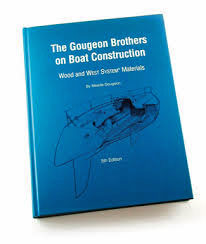
We discussed all this at length, and made a number of sketches of both the interior layout and an efficient, workable cockpit .
Andrew did the number crunching and came up with an outline design for a 38ft (11.5m) cutter rigged wood/epoxy (cedar strip) water-ballasted cruising boat.
"She'll be light, quick, robust and comfortable" he said
"And seaworthy?" we asked
"Eminently so" he replied
"Right" we said, "Let's do it!"
And so we did...
So How Did We Build Alacazam ?
Here's the whole story, in words and pictures.
How to Build a Boat:
- Part 1: The All-Important Preparation
- Part 2: How to Build a Boat Hull in Western Red Cedar
- Part 3: Sheathing the Hull in Woven Glass Rovings
- Part 4: Cutting and Installing the Plywood Bulkheads
- Part 5: Building the Interior Structure
- Part 6: Constructing the Deck and Coach Roof
- Part 7: Moulding the GRP Cabin Top
- Part 8: Fitting the Bulb Keel
- Part 9: Making the Rudder
Next: How to Build a Boat, Part 1
Recent Articles
'Natalya', a Jeanneau Sun Odyssey 54DS for Sale
Mar 17, 24 04:07 PM
'Wahoo', a Hunter Passage 42 for Sale
Mar 17, 24 08:13 AM
Used Sailing Equipment For Sale
Feb 28, 24 05:58 AM
Here's where to:
- Find Used Sailboats for Sale...
- Find Used Sailing Gear for Sale...
- List your Sailboat for Sale...
- List your Used Sailing Gear...
Our eBooks...

A few of our Most Popular Pages...

Copyright © 2024 Dick McClary Sailboat-Cruising.com

Driftboat Wood Kit
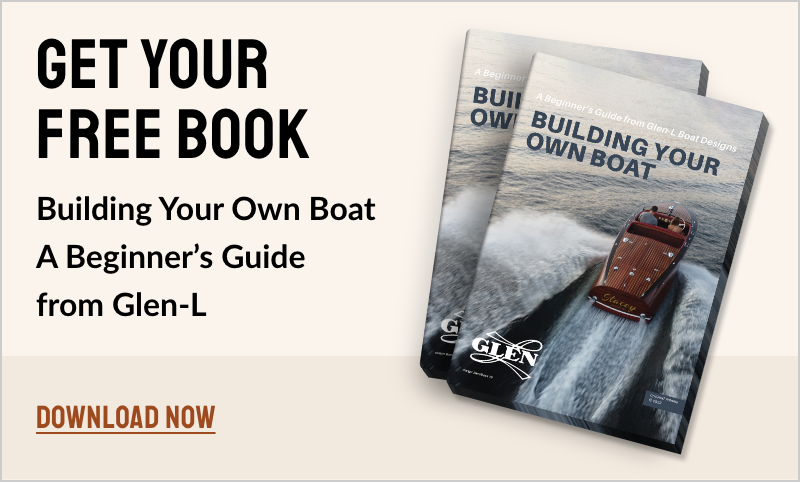
Boatbuilders FORUM
Boat plans, patterns and supplies for the amateur boat builder.
Every year, thousands of amateurs much like yourself build their own boats the proven Glen-L way. Many builders save 50% or more over the price of a factory-built boat. It’s easier than you might think, and it can be a rewarding experience.
Industry experts
Established in 1953
300+ Models
International shipping
Plans & Patterns

All plans come with a 30-Day money back guarantee.

Providing boat Plans & memories Since 1953
For more than 60 years Glen-L has been the world’s premier supplier of boat plans and patterns designed for the amatuer builder. We make it even simpler by offering associated supplies and hardware kits for each design.

More Products

Boatbuilding hardware

Books, DVDs, & Audio

Tools & Raptor® Fastenings

Epoxy and Supplies
Featured designs.

View Plan Details

Cabin Skiff


- About Modern Wooden Boats
- Tips & tricks
- What’s inside a boat plan ?

Idea 21 sportboat
The development of the family of small offshore capable sailboat plans : chined hull for the highest stability, vertical lifting keel, trailerable, suitable for club racing or cruising (two interior versions) , plywood and epoxy hull with the radius chine system, sparkling performances while sailing and reasonable interiors for coastal cruising.
First boat launched : read the first impressions here
Idea 21 small sailboat plan is the latest development of my family of small plywood & epoxy sailboats plans for homebuilders : it was quite a time since i was thinking of an evolution of her smaller 19 footer sister, so i finally take the decision to publish this new plan. the goals of this plan is simple: add interior volume, simplify the work for homebuilders switching to a complete plywood & epoxy radius chine hull, enhance slightly the sparkling performances of idea 19, keeping the sailboat very balanced and suited for sailors ranging from enthusiast beginners to experienced seamen., first boat launched and several other boats in building stage make idea21 the most sparkling project on our catalogue, hull: chined hull on a small light sailboat has a simple reason to exist: it gives more stability to the sailboat when heeled, much more than a round hull similar sailboat. i managed to keep a very low wetted area of the unheeled hull, in order to achieve a good pace in light air and avoid excessive drag. stern sections are quite flat to gain speed downwind (idea 19 has been clocked with speed steadily in excess of 15 knots)., bow sections: experiences on racers showed that “knife-blade” bows may give you less resistance, but the price to pay is high in terms of buried bow sailing downwind, so i decide to provide this plan a large u-shaped section on the bow ; sails provide the sailboat plenty of power to defeat the small amount of added drag., sailplan: i have a very good starting point with idea 19, so we’re doing small adjustments and no revolutions: square top mainsail, 7/8 fractional rig , very wide single swept spreaders, no backstay, deck stepped mast with sturdy section, 110 % j jib, code zero, jennaker hoisted on swinging retractable bowsprit, and a good amount of sail area., keel and ballast: idea21 have a solid hard wood cored & unidirectional glass epoxy laminated lifting keel, with a naca optimised profile and a low resistance hydrodynamical shaped 280 kg lead bulb bolted on the keel tip; it can be made by a homebuilder, no need for professional welder; the fin area is on the low side, speed will help generating the required lift without adding too much drag. keel case is in 20 mm thickness plywood and epoxy laminated glass reinforcements, and it’s perfectly waterproof while sailing., full lifting keel version : after a request from a builder, idea 21 cruise is available in a version featuring an integral watertight keel case running form hull bottom to cabin top panels, this feature called flk (full lifting keel) will allow the boat to sail with keel partially raised or to motor with keel totally up, a good option if you sail in shallow waters frequently., cockpit: was one of the strongest point in idea19, we simply keep the same arrangement and dimensions, so we have a really huge area for the crew and a simple and sturdy building in plywood panels epoxy glued on a structure of bulkheads and stringers., interiors: here i focussed on several upgrades; i decided to split the project in two versions (so two different sets of plans, you have to specify on order), “sport cruise” or “racing” ; both versions have 4 berths, a classic v berth on bow and two quarter berth after; in the cruising version cabin is 55 cm longer, giving wider interiors, enough room for a separate toilette and more comfortable after berths ; in the racing version we have a marine toilet (there’s room for a jabsco compact one) under the bow v-berth; cabin height is 1.65 m in both versions. interiors plywood panels are detailed on plans., taking advantage form the first season of sailing, i can now say that i strongly advice the cruise version as long as you are not going to run a sailing school, thus needing extra space in the cockpit., wooden rig: starting form summer 2019 we deliver two extra drawings with the plans, both for race and cruise version, describing how to build a wooden rig suited for this boat. keep your budget low at the price of a small extra weight , how to build the boat: we chose the plywood & epoxy resin “radius chine” system, as for petrel 28 and hirundo 750, so the hull planking is in okume marine grade plywood ; planking the hull is quite fast , and the internal structure of the boat is made by plywood bulkheads, floors and solid wood longitudinal stringers, all glued with epoxy and strengthened with epoxy laminated glass tape, assembled on a cheap wood scaffold, keeping the hull light, sturdy and quite easy to build for homebuilders ; the goal is to keep the total weight of the 19 footer, raising the ballast fraction of the sailboat at the same time. here are a couple of pictures of the first planked hull perfectly showing the radius chine planking system.
a HUGE Thanks to Nils Theurer ([email protected]) for the awesome pictures taken during the first sea trials

Plans availability: Plans are available in italian and english. Plans are available in imperial units upon request (send me a mail before purchase).
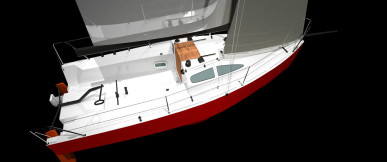
By continuing to use the site, you agree to the use of cookies. more information Accept
The cookie settings on this website are set to "allow cookies" to give you the best browsing experience possible. If you continue to use this website without changing your cookie settings or you click "Accept" below then you are consenting to this.
RETURN TO HOME PAGE
Yachting Monthly
- Digital edition

25 of the best small sailing boat designs
- Nic Compton
- August 10, 2022
Nic Compton looks at the 25 yachts under 40ft which have had the biggest impact on UK sailing

There’s nothing like a list of best small sailing boat designs to get the blood pumping.
Everyone has their favourites, and everyone has their pet hates.
This is my list of the 25 best small sailing boat designs, honed down from the list of 55 yachts I started with.
I’ve tried to be objective and have included several boats I don’t particularly like but which have undeniably had an impact on sailing in the UK – and yes, it would be quite a different list if I was writing about another country.
If your favourite isn’t on the best small sailing boat designs list, then send an email to [email protected] to argue the case for your best-loved boat.
Ready? Take a deep breath…

Credit: Bob Aylott
Laurent Giles is best known for designing wholesome wooden cruising boats such as the Vertue and Wanderer III , yet his most successful design was the 26ft Centaur he designed for Westerly, of which a remarkable 2,444 were built between 1969 and 1980.
It might not be the prettiest boat on the water, but it sure packs a lot of accommodation.
The Westerly Centaur was one of the first production boats to be tank tested, so it sails surprisingly well too. Jack L Giles knew what he was doing.
Colin Archer

Credit: Nic Compton
Only 32 Colin Archer lifeboats were built during their designer’s lifetime, starting with Colin Archer in 1893 and finishing with Johan Bruusgaard in 1924.
Yet their reputation for safety spawned hundreds of copycat designs, the most famous of which was Sir Robin Knox-Johnston ’s Suhaili , which he sailed around the world singlehanded in 1968-9.
The term Colin Archer has become so generic it is often used to describe any double-ender – so beware!
Contessa 32
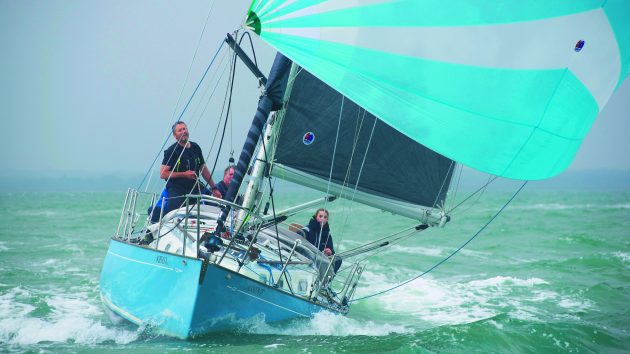
Assent ‘s performance in the 1979 Fastnet Race makes the Contessa 32 a worth entry in the 25 best small sailing boat designs list. Credit: Nic Compton
Designed by David Sadler as a bigger alternative to the popular Contessa 26, the Contessa 32 was built by Jeremy Rogers in Lymington from 1970.
The yacht’s credentials were established when Assent , the Contessa 32 owned by Willy Kerr and skippered by his son Alan, became the only yacht in her class to complete the deadly 1979 Fastnet Race .
When UK production ceased in 1983, more than 700 had been built, and another 20 have been built since 1996.
Cornish Crabber 24

It seemed a daft idea to build a gaff-rigged boat in 1974, just when everyone else had embraced the ‘modern’ Bermudan rig.
Yet the first Cornish Crabber 24, designed by Roger Dongray, tapped into a feeling that would grow and grow and eventually become a movement.
The 24 was followed in 1979 by the even more successful Shrimper 19 – now ubiquitous in almost every harbour in England – and the rest is history.
Drascombe Lugger
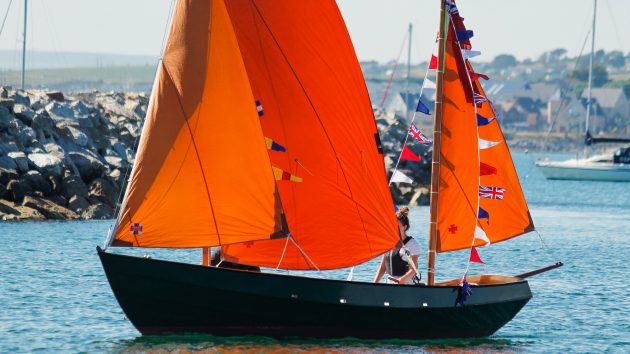
Credit: David Harding
There are faster, lighter and more comfortable boats than a Drascombe Lugger.
And yet, 57 years after John Watkinson designed the first ‘lugger’ (soon changed to gunter rig), more than 2,000 have been built and the design is still going strong.
More than any other boat, the Drascombe Lugger opened up dinghy cruising, exemplified by Ken Duxbury’s Greek voyages in the 1970s and Webb Chiles’s near-circumnavigation on Chidiock Tichbourne I and II .

The 26ft Eventide. Credit: David Harding
It’s been described as the Morris Minor of the boating world – except that the majority of the 1,000 Eventides built were lovingly assembled by their owners, not on a production line.
After you’d tested your skills building the Mirror dinghy, you could progress to building a yacht.
And at 24ft long, the Eventide packed a surprising amount of living space.
It was Maurice Griffiths’ most successful design and helped bring yachting to a wider audience.

You either love ’em or you hate ’em – motorsailers, that is.
The Fisher 30 was brought into production in 1971 and was one of the first out-and-out motorsailers.
With its long keel , heavy displacement and high bulwarks, it was intended to evoke the spirit of North Sea fishing boats.
It might not sail brilliantly but it provided an exceptional level of comfort for its size and it would look after you when things turned nasty.
Significantly, it was also fitted with a large engine.

Credit: Rupert Holmes
It should have been a disaster.
In 1941, when the Scandinavian Sailing Federation couldn’t choose a winner for their competition to design an affordable sailing boat, they gave six designs to naval architect Tord Sundén and asked him to combine the best features from each.
The result was a sweet-lined 25ft sloop which was very seaworthy and fast.
The design has been built in GRP since the 1970s and now numbers more than 4,000, with fleets all over the world.

Credit: Kevin Barber
There’s something disconcerting about a boat with two unstayed masts and no foresails, and certainly the Freedom range has its detractors.
Yet as Garry Hoyt proved, first with the Freedom 40, designed in collaboration with Halsey Herreshoff, and then the Freedom 33 , designed with Jay Paris, the boats are simple to sail (none of those clattering jib sheets every time you tack) and surprisingly fast – at least off the wind .
Other ‘cat ketch’ designs followed but the Freedoms developed their own cult following.
Hillyard 12-tonner

The old joke about Hillyards is that you won’t drown on one but you might starve to death getting there.
And yet this religious boatbuilder from Littlehampton built up to 800 yachts which travelled around the world – you can find them cruising far-flung destinations.
Sizes ranged from 2.5 to 20 tons, though the 9- and 12-ton are best for long cruises.

The innovations on Jester means she is one of the best small sailing boat designs in the last 100 years. Credit: Ewen Southby-Tailyour
Blondie Hasler was one of the great sailing innovators and Jester was his testing ground.
She was enclosed, carvel planked and had an unstayed junk rig.
Steering was via a windvane system Hasler created.
Hasler came second in the first OSTAR , proving small boats can achieve great things.

Moody kicked off the era of comfort-oriented boats with its very first design.
The Moody 33, designed by Angus Primrose, had a wide beam and high topside to produce a voluminous hull .
The centre cockpit allowed for an aft cabin, resulting in a 33-footer with two sleeping cabins – an almost unheard of concept in 1973 –full-beam heads and spacious galley.
What’s more, her performance under sail was more than adequate for cruising.
Finally, here was a yacht that all the family could enjoy.
Continues below…

What makes a boat seaworthy?
What characteristics make a yacht fit for purpose? Duncan Kent explores the meaning of 'seaworthy' and how hull design and…

How boat design is evolving
Will Bruton looks at the latest trends and innovations shaping the boats we sail

How keel type affects performance
James Jermain looks at the main keel types, their typical performance and the pros and cons of each

Boat handling: How to use your yacht’s hull shape to your advantage
Whether you have a long keel or twin keel rudders, there will be pros and cons when it comes to…
Nicholson 32

Credit: Genevieve Leaper
Charles Nicholson was a giant of the wooden boat era but one of his last designs – created with his son Peter – was a pioneering fibreglass boat that would become an enduring classic.
With its long keel and heavy displacement, the Nicholson 32 is in many ways a wooden boat built in fibreglass – and indeed the design was based on Nicholson’s South Coast One Design.
From 1966 to 1977, the ‘Nic 32’ went through 11 variations.

Credit: Hallberg-Rassy
In the beginning there was… the Rasmus 35. This was the first yacht built by the company that would become Hallberg-Rassy and which would eventually build more than 9,000 boats.
The Rasmus 35, designed by Olle Enderlein, was a conservative design, featuring a centre cockpit, long keel and well-appointed accommodation.
Some 760 boats were built between 1967 and 1978.

Credit: Larry & Lin Pardey
Lyle Hess was ahead of his time when he designed Renegade in 1949.
Despite winning the Newport to Ensenada race, the 25ft wooden cutter went largely unnoticed.
Hess had to build bridges for 15 years before Larry Pardey asked him to design the 24ft Seraffyn , closely based on Renegade ’s lines but with a Bermudan rig.
Pardey’s subsequent voyages around the world cemented Hess’s reputation and success of the Renegade design.

Would the Rustler 36 make it on your best small sailing boat list? Credit: Rustler Yachts
Six out of 18 entries for the 2018 Golden Globe Race (GGR) were Rustler 36s, with the top three places all going to Rustler 36 skippers.
It was a fantastic endorsement for a long-keel yacht designed by Holman & Pye 40 years before.
Expect to see more Rustler 36s in the 2022 edition of the GGR!

It was Ted Heath who first brought the S&S 34 to prominence with his boat Morning Cloud .
In 1969 the yacht won the Sydney to Hobart Race, despite being one of the smallest boats in the race.
Other epic S&S 34 voyages include the first ever single-handed double circumnavigation by Jon Sanders in 1981

Credit: Colin Work
The Contessa 32 might seem an impossible boat to improve upon, but that’s what her designer David Sadler attempted to do in 1979 with the launch of the Sadler 32 .
That was followed two years later by the Sadler 29 , a tidy little boat that managed to pack in six berths in a comfortable open-plan interior.
The boat was billed as ‘unsinkable’, with a double-skinned hull separated by closed cell foam buoyancy.
What’s more, it was fast, notching up to 12 knots.

Credit: Dick Durham/Yachting Monthly
Another modern take on the Contessa theme was the Sigma 33, designed by David Thomas in 1979.
A modern underwater body combined with greater beam and higher freeboard produced a faster boat with greater accommodation.
And, like the Contessa, the Sigma 33 earned its stripes at the 1979 Fastnet, when two of the boats survived to tell the tale.
A lively one-design fleet soon developed on the Solent which is still active to this day.

A replica of Joshua Slocum’s Spray . Credit: Alamy Stock Photo
The boat Joshua Slocum used for his first singlehanded circumnavigation of the world wasn’t intended to sail much further than the Chesapeake Bay.
The 37ft Spray was a rotten old oyster sloop which a friend gave him and which he had to spend 13 months fixing up.
Yet this boxy little tub, with its over-optimistic clipper bow, not only took Slocum safely around the world but has spawned dozens of modern copies that have undertaken long ocean passages.

Credit: James Wharram Designs
What are boats for if not for dreaming? And James Wharram had big dreams.
First he sailed across the Atlantic on the 23ft 6in catamaran Tangaroa .
He then built the 40ft Rongo on the beach in Trinidad (with a little help from French legend Bernard Moitessier) and sailed back to the UK.
Then he drew the 34ft Tangaroa (based on Rongo ) for others to follow in his wake and sold 500 plans in 10 years.

Credit: Graham Snook/Yachting Monthly
The Twister was designed in a hurry.
Kim Holman wanted a boat at short notice for the 1963 season and, having had some success with his Stella design (based on the Folkboat), he rushed out a ‘knockabout cruising boat for the summer with some racing for fun’.
The result was a Bermudan sloop that proved nigh on unbeatable on the East Anglian circuit.
It proved to be Holman’s most popular design with more than 200 built.

Credit: Alamy Stock Photo
Laurent Giles’s design No15 was drawn in 1935 for a Guernsey solicitor who wanted ‘a boat that would spin on a sixpence and I could sail single-handed ’.
What the young Jack Giles gave him was a pretty transom-sterned cutter, with a nicely raked stem.
Despite being moderate in every way, the boat proved extremely able and was soon racking up long distances, including Humphrey Barton’s famous transatlantic crossing on Vertue XXXV in 1950.
Wanderer II and III

Credit: Thies Matzen
Eric and Susan Hiscock couldn’t afford a Vertue, so Laurent Giles designed a smaller, 21ft version for them which they named Wanderer II .
They were back a few years later, this time wanting a bigger version: the 30ft Wanderer III .
It was this boat they sailed around the world between 1952-55, writing articles and sailing books along the way.
In doing so, they introduced a whole generation of amateur sailors to the possibilities of long-distance cruising.
Westerly 22

The origins of Westerly Marine were incredibly modest.
Commander Denys Rayner started building plywood dinghies in the 1950s which morphed into a 22ft pocket cruiser called the Westcoaster.
Realising the potential of fibreglass, in 1963 he adapted the design to create the Westerly 22, an affordable cruising boat with bilge keels and a reverse sheer coachroof.
Some 332 boats were built to the design before it was relaunched as the Nomad (267 built).
Enjoyed reading 25 of the best small sailing boat designs?
A subscription to Yachting Monthly magazine costs around 40% less than the cover price .
Print and digital editions are available through Magazines Direct – where you can also find the latest deals .
YM is packed with information to help you get the most from your time on the water.
- Take your seamanship to the next level with tips, advice and skills from our experts
- Impartial in-depth reviews of the latest yachts and equipment
- Cruising guides to help you reach those dream destinations
Follow us on Facebook , Twitter and Instagram.

10 Best Small Sailboats (Under 20 Feet)

Last Updated by
Daniel Wade
December 28, 2023
Compact, easy to trailer, simple to rig, easy to maintain and manage, and affordable, the best small boats all have one thing in common: they offer loads of fun while out there on the water.
So whether you're on a budget or just looking for something that can offer ultimate daytime rides without compromising on safety, aesthetic sensibilities, alternate propulsion, and speed, the best small sailboats under 20 feet should be the only way to go.
Let's be brutally honest here; not everyone needs a 30-foot sailboat to go sailing. They come with lots of features such as electronics, entertainment, refrigeration, bunks, a galley, and even a head. But do you really need all these features to go sailing? We don't think so.
All you need to go sailing is a hull, a mast, rudder, and, of course, a sail. And whether you refer to them as daysailers, trailerable sailboats , a weekender sailboat, or pocket cruisers, there's no better way to enjoy the thrills of coastal sailing than on small sailboats.
There are a wide range of small boats measuring less than 20 feet available in the market. These are hot products in the market given that they offer immense thrills out on the sea without the commitment required to cruise on a 30-footer. A small sailboat will not only give you the feel of every breeze but will also give you the chance to instantly sense every change in trim.
In this article, we'll highlight 10 best small sailboats under 20 feet . Most models in this list are time-tested, easy to rig, simple to sail, extremely fun, and perfect either for solo sailing or for sailing with friends and family. So if you've been looking for a list of some of the best small sailboats , you've come to the right place.
So without further ado, let's roll on.
Table of contents
{{boat-info="/boats/hunter-15"}}
The Marlow-Hunter 15 is not only easy to own since it's one of the most affordable small sailboats but also lots of fun to sail. This is a safe and versatile sailboat for everyone. Whether you're sailing with your family or as a greenhorn, you'll love the Hunter 15 thanks to its raised boom, high freeboard, and sturdy FRP construction.
With high sides, a comfortable wide beam, a contoured self-bailing cockpit, and fiberglass construction, the Hunter 15 is certainly designed with the novice sailor in mind. This is why you can do a lot with this boat without falling out, breaking it, or capsizing. Its contoured self-baiting cockpit will enable you to find a fast exit while its wide beam will keep it steady and stable no matter what jibes or weight shifts happen along the way.
This is a small sailboat that can hold up to four people. It's designed to give you a confident feeling and peace of mind even when sailing with kids. It's easy to trailer, easy to rig, and easy to launch. With a price tag of about $10k, the Hunter 15 is a fun, affordable, and versatile boat that is perfect for both seasoned sailors and novices. It's a low-maintenance sailboat that can be great for teaching kids a thing or two about sailing.
Catalina 16.5
{{boat-info="/boats/catalina-16-5"}}
Catalina Yachts are synonymous with bigger boats but they have some great and smaller boats too such as Catalina 16.5. This is one of the best small sailboats that are ideal for family outings given that it has a big and roomy cockpit, as well as a large storage locker. Designed with a hand-laminated fiberglass sloop, the Catalina 16.5 is versatile and is available in two designs: the centerboard model and the keel model.
The centerboard model is designed with a powerful sailplane that remains balanced as a result of the fiberglass centerboard, the stable hull form, and the rudder. It also comes with a tiller extension, adjustable hiking straps, and adjustable overhaul. It's important to note that these are standard equipment in the two models.
As far as the keel model is concerned, this is designed with a high aspect keel as the cast lead and is attached with stainless steel keel bolts, which makes this model perfect for mooring or docking whenever it's not in use. In essence, the centerboard model is perfect if you'll store it in a trailer while the keel model can remain at the dock.
All in all, the Catalina 16.5 is one of the best small sailboats that you can get your hands on for as low as $10,000. This is certainly a great example of exactly what a daysailer should be.
{{boat-info="/boats/hobie-16"}}
There's no list of small, trailerable, and fun sailboats that can be complete without the inclusion of the classic Hobie 16. This is a durable design that has been around and diligently graced various waters across the globe since its debut way back in 1969 in Southern California. In addition to being durable, the Hobie 16 is trailerable, great for speed, weighs only 320 pounds, great for four people, and more importantly, offers absolute fun.
With a remarkable figure of over 100,000 launched since its debut, it's easy to see that the Hobie 16 is highly popular. Part of this popularity comes from its asymmetric fiberglass-and-foam sandwiched hulls that include kick-up rudders. This is a great feature that allows it to sail up to the beach.
For about $12,000, the Hobie 16 will provide you with endless fun throughout the summer. It's equipped with a spinnaker, trailer, and douse kit. This is a high-speed sailboat that has a large trampoline to offer lots of space not just for your feet but also to hand off the double trapezes.
Montgomery 17
{{boat-info="/boats/montgomery-17"}}
Popularly known as the M-17, The Montgomery 17 was designed by Lyle C. Hess in conjunction with Jerry Montgomery in Ontario, California for Montgomery Boats. Designed either with keel or centerboard models, the M-17 is more stable than most boats of her size. This boat is small enough to be trailered but also capable of doing moderate offshore passages.
This small sailboat is designed with a masthead and toe rail that can fit most foresails. It also has enough space for two thanks to its cuddly cabin, which offers a sitting headroom, a portable toilet, a pair of bunks, a DC power, and optional shore, and a proper amount of storage. That's not all; you can easily raise the deck-stepped mast using a four-part tackle.
In terms of performance, the M-17 is one of the giant-killers out there. This is a small sailboat that will excel in the extremes and make its way past larger boats such as the Catalina 22. It glides along beautifully and is a dog in light air, though it won't sail against a 25-knot wind, which can be frustrating. Other than that, the Montgomery 17 is a great small sailboat that can be yours for about $14,000.
Norseboat 17.5
{{boat-info="/boats/norseboat-17-5"}}
As a versatile daysailer, Norseboat 17.5 follows a simple concept of seaworthiness and high-performance. This small sailboat perfectly combines both contemporary construction and traditional aesthetics. Imagine a sailboat that calls itself the "Swiss Army Knife of Boats!" Well, this is a boat that can sail and row equally well.
Whether you're stepping down from a larger cruiser or stepping up from a sea kayak, the unique Norseboat 17.5 is balanced, attractive, and salty. It has curvaceous wishbone gaff, it is saucy, and has a stubby bow-sprit that makes it attractive to the eyes. In addition to her beauty, the Norseboat 17.5 offers an energy-pinching challenge, is self-sufficient, and offers more than what you're used to.
This is a small, lightweight, low-maintenance sailboat that offers a ticket to both sailing and rowing adventures all at the same time. At about 400 pounds, it's very portable and highly convenient. Its mainsails may look small but you'll be surprised at how the boat is responsive to it. With a $12,500 price tag, this is a good small sailboat that offers you the versatility to either row or sail.
{{boat-info="/boats/sage-marine-sage-17"}}
If you've been looking for a pocket cruiser that inspires confidence, especially in shoal water, look no further than the Sage 17. Designed by Jerry Montgomery in 2009, the Sage 17 is stable and should heel to 10 degrees while stiffening up. And because you want to feel secure while sailing, stability is an integral feature of the Sage 17.
This is a sailboat that will remain solid and stable no matter which part of the boat you stand on. Its cabin roof and the balsa-cored carbon-fiber deck are so strong that the mast doesn't require any form of compression post. The self-draining cockpit is long enough and capable of sleeping at 6 feet 6 inches.
The Sage 17 may be expensive at $25k but is a true sea warrior that's worth look at. This is a boat that will not only serve you right but will also turn heads at the marina.
{{boat-info="/boats/laserperformance-laser-sb3"}}
Having been chosen as the overall boat of the year for 2008 by the Sailing World Magazine, the Laser SB3 is one of the coolest boats you'll ever encounter. When sailing upwind, this boat will lock into the groove while its absolute simplicity is legendary. In terms of downwind sailing, having this boat will be a dream come true while it remains incredibly stable even at extraordinary speed.
Since its debut in 2004, the Laser SB3 has surged in terms of popularity thanks to the fact that it's designed to put all the controls at your fingertips. In addition to a lightweight mast, its T- bulb keel can be hauled and launched painlessly. For about $18,000, the Laser SB3 ushers you into the world of sports sailing and what it feels to own and use a sports boat.
{{boat-info="/boats/fareast-18"}}
As a manufacturer, Fareast is a Chinese boat manufacturer that has been around for less than two decades. But even with that, the Fareast 18 remains a very capable cruiser-racer that will take your sailing to the next level. In addition to its good looks, this boat comes with a retractable keel with ballast bulb, a powerful rig, and an enclosed cabin.
Its narrow design with a closed stern may be rare in sailboats of this size, but that's not a problem for the Fareast 18. This design not only emphasizes speed but also makes it a lot easier to maintain this boat. Perfect for about 6 people, this boat punches above its weight. It's, however, designed to be rigged and launched by one person.
This is a relatively affordable boat. It's agile, safe, well-thought-out, well built, and very sporty.
{{boat-info="/boats/chuck-paine-paine-14"}}
If you're in the market looking for a small sailboat that offers contemporary performance with classic beauty, the Paine 14 should be your ideal option. Named after its famous designer, Chuck Paine, this boat is intentionally designed after the classic Herreshoff 12.5 both in terms of dimensions and features.
This is a lightweight design that brings forth modern fin keel and spade rudder, which makes it agile, stable, and faster. The Paine 14 is built using cold-molded wood or west epoxy. It has varnished gunnels and transoms to give it an old-time charm. To make it somehow modern, this boat is designed with a carbon mast and a modern way to attach sails so that it's ready to sail in minutes.
You can rest easy knowing that the Paine 14 will not only serve you well but will turn heads while out there.
{{boat-info="/boats/wd-schock-lido-14"}}
Many sailors will attest that their first sailing outing was in a Lido 14. This is a classic sailboat that has been around for over four decades and still proves to be a perfect match to modern small boats, especially for those still learning the ropes of sailing.
With seating for six people, the Lido 14 can be perfect for solo sailing , single-handed sailing, or if you're planning for shorthanded sailing. While new Lido 14 boats are no longer available, go for a functional used Lido 14 and you'll never regret this decision. It will serve you well and your kids will probably fall in love with sailing if Lido 14 becomes their main vessel during weekends or long summer holidays.
Bottom Line
There you have it; these are some of the best small sailboats you can go for. While there are endless small sailboats in the market, the above-described sailboat will serve you right and make you enjoy the wind.
Choose the perfect sailboat, invest in it, and go out there and have some good fun!
Related Articles
I've personally had thousands of questions about sailing and sailboats over the years. As I learn and experience sailing, and the community, I share the answers that work and make sense to me, here on Life of Sailing.
by this author
Best Sailboats
Most Recent

What Does "Sailing By The Lee" Mean?
October 3, 2023

The Best Sailing Schools And Programs: Reviews & Ratings
September 26, 2023
Important Legal Info
Lifeofsailing.com is a participant in the Amazon Services LLC Associates Program, an affiliate advertising program designed to provide a means for sites to earn advertising fees by advertising and linking to Amazon. This site also participates in other affiliate programs and is compensated for referring traffic and business to these companies.
Similar Posts

Affordable Sailboats You Can Build at Home
September 13, 2023

Best Small Sailboats With Standing Headroom

Best Bluewater Sailboats Under $50K
Popular posts.

Best Liveaboard Catamaran Sailboats

Can a Novice Sail Around the World?
Elizabeth O'Malley
June 15, 2022

4 Best Electric Outboard Motors

How Long Did It Take The Vikings To Sail To England?

10 Best Sailboat Brands (And Why)
December 20, 2023


7 Best Places To Liveaboard A Sailboat
Get the best sailing content.
Top Rated Posts
Lifeofsailing.com is a participant in the Amazon Services LLC Associates Program, an affiliate advertising program designed to provide a means for sites to earn advertising fees by advertising and linking to Amazon. This site also participates in other affiliate programs and is compensated for referring traffic and business to these companies. (866) 342-SAIL
© 2024 Life of Sailing Email: [email protected] Address: 11816 Inwood Rd #3024 Dallas, TX 75244 Disclaimer Privacy Policy
Elliott News
Build yourself a sailboat.

20 Apr 2020
Here’s a great project for you weekend warriors with basic tools and skills, who want to build your own yacht. It’s the E22 Day Sailer. A perfect backyard project for you, the E22 DS is a simple, tough, day sailer, you can drag it up onto the beach or onto the lawn at the bach with minimum fuss and it's robust enough to handle this treatment. You can choose from several construction options available . We can supply you with construction plans and a materials list to build your own yacht from scratch. If you’re handy with tools and have the time this option will work for you. Want to cut out the first few steps and get a jump start ? The materials can be supplied as a flatpack boat to construct with your basic building skills. The E22 DS has been designed for easy construction of the basic frame, before applying the plywood panels. Bond the deck plywood panels at the edges and glass tape to form the shape. Economical too - the computer-cut panels are supplied with greater accuracy and less wastage, as the patterns are cut to achieve the greatest efficiency. The bulkheads and bottom panels utilise 9mm ply, while the topsides and deck are 6mm. Sheath the hull in fibre glass with an extra layer along the bottom to resist abrasion and you’re nearly sailing. The third build option - possibly the fastest and definitely the easiest, just purchase the flatpack and have it delivered to your local boat builder to put it together professionally for you. Sailing Details. Just two small winches take care of headsail sheeting and swinging the keel plate up. There is enough weight in the keel to ensure the boat is self-righting.Next pick up a pre loved mast and some sails or choose from a variety of mast and sail options to suit your budget and sailing preferences. Your Elliott 22 DS is Fun to Build – Fun to Sail. Read more Here or Jump in now and get in touch with us to get started now.
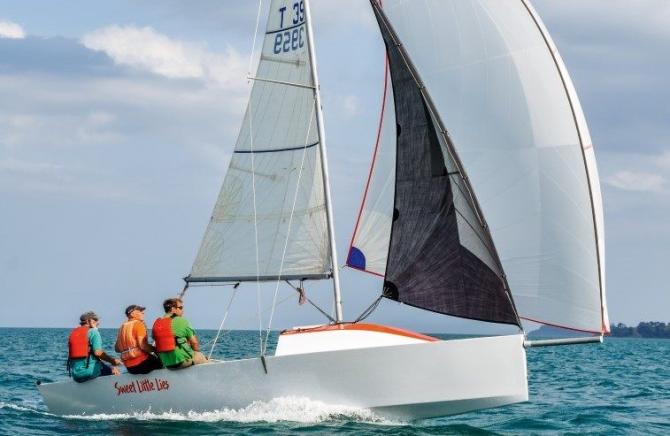

Step-By-Step Guide: How to Build a Wooden Sailboat – Complete DIY Tutorial
Alex Morgan
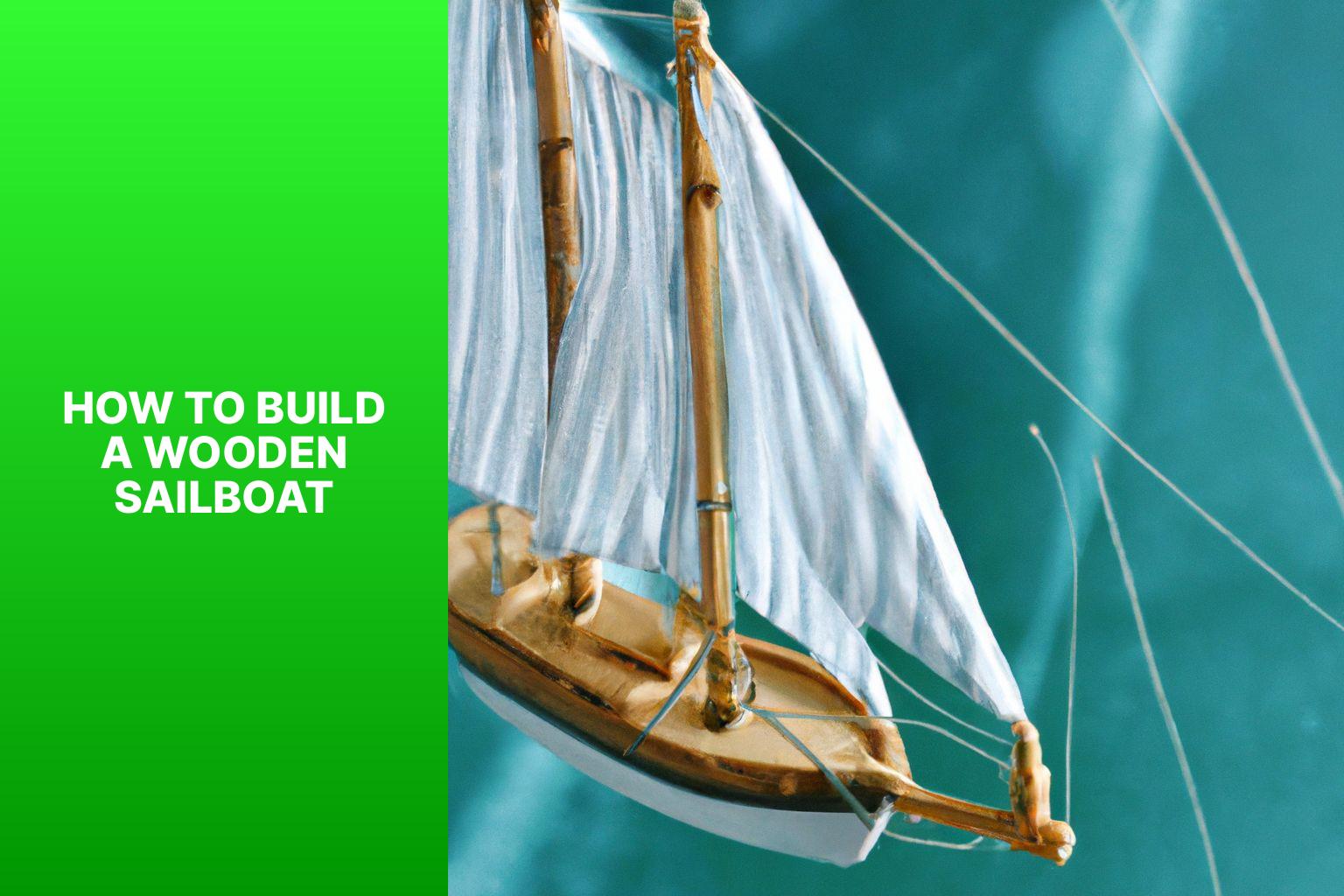
Building a wooden sailboat is a rewarding and fulfilling endeavor that allows you to create your own vessel for sailing adventures. Whether you’re a seasoned sailor or a woodworking enthusiast, constructing a wooden sailboat requires careful planning, attention to detail, and a love for craftsmanship. This comprehensive guide will take you through the step-by-step process of building a wooden sailboat, from choosing the right design and gathering the necessary materials to assembling the framework, building the deck and cabin, and installing the sails and rigging. We will also discuss the finishing touches and regular maintenance required to keep your wooden sailboat in optimal condition for years of enjoyment on the water. Let’s dive into the world of wooden sailboat construction and embark on this exciting journey together.
Key takeaways:
Key takeaway:
- Choosing the right design and plans is crucial: Research different sailboat designs and select suitable plans based on your skill level to ensure a successful project.
- Gather the necessary materials and tools: Pay attention to wood selection and preparation, as well as acquiring the tools and equipment needed for building your wooden sailboat.
- Attention to detail in the construction process is important: Prepare and assemble the framework carefully, focusing on lofting, laying out the keel, constructing the ribs, and the hull structure to ensure a sturdy and reliable sailboat.
Choosing the Right Design and Plans
When it comes to building a wooden sailboat, one of the crucial steps is choosing the right design and plans. In this section, we’ll take a deep dive into the world of sailboat designs and explore the vast array of options available. From researching different sailboat designs to selecting plans that match your skill level, we’ll guide you through the exciting process of bringing your wooden sailboat dream to life. So, hop aboard and let’s set sail on this exhilarating journey of craftsmanship and adventure.
Researching Different Sailboat Designs
When conducting research on sailboat designs, it is important to take into account a variety of factors in order to select the most suitable design. One of the primary considerations is whether you prefer a monohull or a multihull sailboat. Monohulls are more commonly found and offer superior performance when sailing upwind, whereas multihulls provide both stability and speed.
Another aspect to consider is your level of sailing experience. If you are a beginner, it is advisable to seek out designs that are easier to handle and forgiving. On the other hand, experienced sailors may gravitate towards performance-oriented designs that are ideal for racing or long-distance cruising.
It is crucial to think about how you intend to use the sailboat. Are you looking for a day sailer , a cruiser , or a racing boat ? Each design comes with its own set of distinctive features and characteristics.
Determining the appropriate size of the sailboat is another crucial step, which should be based on the number of people and activities you plan to have on board. You must also decide whether you prefer an open cockpit or an enclosed cabin .
To find the perfect sailboat design that aligns with your sailing goals and preferences, it is imperative to thoroughly research various options and take into consideration all of these factors. By doing so, you will be able to make an informed decision and select the ideal sailboat design.
Selecting Suitable Plans for Your Skill Level
When it comes to building a wooden sailboat, it is crucial to select suitable plans that match your skill level. This is important as it ensures that you have the necessary knowledge and expertise to effectively complete the construction. In order to help you with this, here is a table that outlines the different skill levels and the corresponding plans:
Choosing the right plans for your skill level is essential as it enables you to navigate the construction process smoothly, avoid any complications, and ultimately achieve the desired result. It is crucial to honestly evaluate your woodworking skills and then select plans that align with your abilities. Keep in mind that building a wooden sailboat demands patience , attention to detail , and a willingness to learn and improve your woodworking skills.
As a pro tip, if you are a beginner, it is advisable to start with simpler plans and gradually work your way up to more complex projects. This allows you to gain experience and confidence in your woodworking abilities over time. So always remember to select suitable plans for your skill level and enjoy the process of building your wooden sailboat.
Gathering the Necessary Materials and Tools
When it comes to building a wooden sailboat, gathering the necessary materials and tools is key . In this section, we’ll dive into the exciting world of selecting and preparing the right wood for your sailboat, as well as the essential tools and equipment you’ll need to bring your project to life. So, start sharpening your creativity and let’s sail away into the realm of wooden boat construction!
Wood Selection and Preparation
Incorporating the provided keywords naturally in the provided text:
1. Conduct research on the different types of wood used in boatbuilding, such as mahogany , teak , or oak . This will help you make an informed decision regarding the most suitable wood for your sailboat.
2. Determine the specific requirements of your sailboat design in order to guide your wood selection process. Each design may have different needs and preferences when it comes to the type of wood to be used.
3. Take into consideration the durability and resistance to rot of the wood options available. This is crucial to ensure the longevity and overall quality of your sailboat. Choosing a wood that can withstand exposure to water and other elements is essential.
4. Look for straight , dry , and defect-free wood. This will contribute to the structural integrity of your sailboat. Any defects or irregularities in the wood may compromise its strength and performance.
5. Calculate the amount of wood needed based on the specific design and measurements of your sailboat. This will help you estimate the quantity of wood required for the construction process.
6. Mill or cut the wood into the required dimensions and shapes as outlined in the sailboat design. This step is crucial for achieving the desired structure and appearance of your sailboat.
7. Prior to assembly, it is important to sand the wood surfaces thoroughly. This will remove any rough edges or splinters, ensuring a smooth and safe finish.
8. Apply a protective coating or sealant to the wood in order to prevent water damage. This will help preserve the wood and extend its lifespan .
By following these steps, you can ensure that the wood selected and prepared for your sailboat construction is suitable and of high quality.
Tools and Equipment Needed for the Project
When embarking on the construction of a wooden sailboat, it is crucial to have the appropriate tools and equipment to ensure successful completion.
To accurately measure and obtain precise alignment and dimensions, essential measuring tools such as a tape measure , combination square , and level are indispensable.
For shaping wooden components, cutting tools like a circular saw or table saw , jigsaw , and hand saw are necessary.
Joinery tools, including a chisel set , mallet or hammer , and drill with different-sized bits, are vital for smoothly joining parts together.
To achieve a polished finish, sanding and finishing tools such as sandpaper with varying grits, sanding blocks , and a random orbital sander are crucial.
Additionally, brushes and rollers are required for the application of finishes.
When it comes to safety, it is imperative to prioritize the use of safety goggles , ear protection , a dust mask , and work gloves to ensure personal protection during the construction process.
When selecting tools and equipment, it is essential to invest in high-quality items that are specifically designed for the tasks involved in wooden sailboat building.
By doing so, not only will efficiency be maximized, but the overall quality of the finished boat will also be greatly enhanced.
Preparing and Assembling the Framework
As we delve into the world of building a wooden sailboat, we now find ourselves in the exciting phase of preparing and assembling the framework. In this section, we’ll discover the essential steps that go into setting up the lofting and laying out the keel , as well as the intricacies of constructing the ribs and hull structure. Get ready to immerse yourself in the hands-on process of bringing this magnificent vessel to life!
Setting Up the Lofting and Laying Out the Keel
To properly set up the lofting and lay out the keel for a wooden sailboat, it is important to follow these steps in a systematic manner:
- Firstly, prepare the lofting area by clearing a large, flat space where the plans and measurements will be placed.
- Next, securely attach the keel stock to the lofting platform, making sure it is both level and aligned with the boat’s centerline.
- Using battens, rulers, and pencils, transfer the measurements and lines from the boat plans onto the lofting platform.
- Ensure the accuracy of the waterlines, buttock lines, and other reference lines on the lofting platform by drawing them according to the measurements provided in the boat plans.
- Utilizing the dimensions indicated in the plans, measure and mark the positions of the keel, stem, and transom on the lofting platform.
- Thoroughly examine and adjust all lines and measurements to guarantee their accuracy.
- Identify the locations where any additional frames, bulkheads, or structural elements will connect to the keel, by marking them accordingly.
- Prior to proceeding, double-check all marks and measurements to ensure their accuracy.
The process of setting up the lofting and laying out the keel is an integral step in the construction of a wooden sailboat. It serves as the foundation and reference points for the boat’s overall structure. It is crucial to pay close attention to detail and maintain accuracy throughout the build. By following these steps, you will be on your way to constructing your very own wooden sailboat.
Constructing the Ribs and Hull Structure
When constructing the ribs and hull structure of a wooden sailboat, follow these steps:
– Measure and cut the ribs: Use the plans as a guide to mark and cut the dimensions on the wood. Cut the ribs accurately.
– Attach the ribs to the keel: Position and attach the cut ribs evenly along the keel using marine epoxy and screws.
– Install chines and stringers: Attach the chines to the bottom edge of the boat and install the stringers along the sides for strength.
– Attach the planking: Cut and fit planks to cover the rib and stringer structure, securing them tightly.
– Reinforce the joints: Apply epoxy and fiberglass tape over the joints to strengthen the structure.
– Shape the hull: Use tools to shape and smooth the hull, paying attention to fairing for optimal hydrodynamics.
– Apply a protective finish: Coat the hull and ribs with marine-grade varnish or epoxy for durability.
– Perform a thorough inspection: Check for defects, cracks, or imperfections and make necessary repairs before moving forward.
The process of constructing wooden sailboats has evolved over time, combining traditional techniques with modern materials and tools. Craftsmanship, attention to detail, and an understanding of wood’s properties are still essential in constructing the ribs and hull structure. This blend of artistry and engineering ensures sailboats can withstand the demands of the sea while providing a smooth and enjoyable sailing experience.
Building the Deck and Cabin
Let’s dive into the exciting world of building a wooden sailboat! In this section, we’ll focus on the crucial element of constructing the deck and cabin. Get ready to explore the process of creating the deck framework and adding those essential interior features . From laying the foundation to crafting a cozy cabin space , we’ll uncover the key steps and considerations for bringing your wooden sailboat to life. So, grab your tools and let’s set sail on this exhilarating construction journey !
Creating the Deck Framework
When creating the deck framework for a wooden sailboat, follow these steps:
- Measure and mark the desired deck size and shape on the boat’s frame.
- Cut and shape the wooden planks or panels to match the marked measurements.
- Align the planks or panels horizontally across the frame, ensuring they are straight and evenly spaced.
- Secure the planks or panels to the frame using screws or nails, ensuring tight fastening.
- Add additional support beams or joists underneath the deck for added strength and stability.
- Sand the deck surface to create a smooth and even finish.
- Apply a weather-resistant sealant or paint to protect the deck from moisture and UV damage.
- Install necessary features or fixtures on the deck, such as hatches, cleats or railings.
Pro-tip: Enhance the deck’s strength and durability by adding epoxy or marine adhesive between the joints before securing the planks or panels.
Installing the Cabin and Interior Features
When building a wooden sailboat, it is important to pay attention to every step, including the installation of the cabin and interior features. To install these features, follow the following steps:
1. First, measure and cut the materials for the cabin walls, floor, and ceiling.
2. Next, securely fit the cabin walls in place.
3. Then, attach the floorboards to the cabin base using screws or nails.
4. Align and install the cabin ceiling.
5. If desired, add insulation for extra comfort.
6. Attach interior features such as cabinets, storage compartments, and seating areas.
7. Install windows and hatches to allow for natural light and ventilation.
8. Properly wire the cabin for electricity, ensuring that lights and outlets are installed and functioning.
9. Finish the interior by sanding and applying a protective coat of varnish or paint.
10. Ensure that all installations meet safety standards.
Precision and attention to detail are key when installing the cabin and interior features of a wooden sailboat. By carefully measuring, cutting, and fitting each component, you can ensure a secure fit. It is important to optimize the layout and functionality of the interior features to create a comfortable living space with ample storage. The addition of windows and hatches will enhance comfort and enjoyment by providing natural light and ventilation . If electricity is needed, proper wiring is essential to ensure necessary lighting and power outlets. Finishing the interior with a protective coat of varnish or paint will not only enhance aesthetics but also provide durability.
Remember, the goal is to create a cozy retreat for sailors, so it is important to put in the necessary effort to install the cabin and interior features correctly.
Installing the Sails and Rigging
Set sail with confidence as we dive into the exciting world of installing the sails and rigging for your wooden sailboat. Discover the key considerations in choosing the perfect sails and master the art of setting up and adjusting the rigging. With expert tips and tricks , this section will equip you with the knowledge to navigate the waters with ease and experience the thrill of sailing your wooden masterpiece .
Choosing the Right Sails
When choosing sails for your wooden sailboat, consider the following factors:
– Type of sailing: Determine if you plan to cruise , race , or do both. Different sails are designed for specific purposes.
– Boat size: The size of your sailboat determines the size and number of sails you need. Larger boats require bigger sails , while smaller boats may need fewer and smaller sails .
– Wind conditions: Consider the typical wind conditions in your sailing areas. Different sails perform better in light winds , heavy winds , or various wind conditions.
– Sail material: The material of the sails affects durability and performance. Material choices include Dacron , laminate , and nylon . Each material has different trade-offs between longevity, performance, and cost.
– Reefing options: If you sail in varied or unpredictable wind conditions, choose sails with reefing options. Reefing allows you to adjust the sail area for stronger winds, improving control and safety.
– Manufacturer reputation: Research sail manufacturers for their reputation and reliability. Read reviews, seek recommendations, and consider warranty and customer support.
By considering these factors, you can make an informed decision when choosing sails for your wooden sailboat. Remember, the right sails greatly impact your sailing experience, so take your time and choose wisely.
Setting Up and Adjusting the Rigging
When setting up and adjusting the rigging of a wooden sailboat, it is important to follow these steps to ensure proper and safe rigging.
To start, attach the mast to the deck using a mast step or mast partner for stability and support. This will provide the foundation for the rigging.
Next, secure the standing rigging , which includes the shrouds and stays , to the mast. This will help distribute the forces from the sails and ensure the stability of the mast.
Connect the forestay to the bow of the sailboat. This will keep the mast in line and control the position of the headsail.
To counteract forces from the headsail and maintain rigging tension, attach the backstay to the stern of the boat.
Use turnbuckles or rigging screws to adjust the tension in the standing rigging. This will ensure proper alignment and support of the mast.
Install the running rigging , including halyards and sheets , to control the position and tension of the sails.
Before and during sailing, it is important to regularly check the tension in the rigging to ensure performance and safety.
Make any necessary adjustments to the rigging during sailing in order to optimize the shape of the sails and enhance the performance of the boat.
By following these steps, you will be able to properly set up and adjust the rigging of your wooden sailboat, allowing for safe and enjoyable sailing experiences.
Finishing Touches and Maintenance
When it comes to completing your wooden sailboat and keeping it in top shape, this section has got you covered. We’ll dive into the art of applying exquisite finishes to the hull and deck, giving your sailboat a stunning appearance. And don’t worry, we won’t neglect the nitty-gritty details of regular maintenance and care, ensuring your wooden vessel remains seaworthy for years to come. So, let’s get ready to add those finishing touches and keep your sailboat sailing smoothly !
Applying Finishes to the Hull and Deck
When building a wooden sailboat, applying finishes to the hull and deck is crucial for durability and aesthetic appeal. Here are the steps to follow:
1. Prepare the surfaces: Sand down rough spots, fill in cracks and imperfections, and ensure a smooth and clean surface.
2. Choose the right finish: Consider the type of wood and desired look. Varnish provides a glossy and traditional appearance, while paint offers different colors and styles.
3. Apply the primer: Enhance adherence and create an even surface for the final coat by applying a primer.
4. Apply the finish: Use a brush or roller to apply the chosen finish coat to the hull and deck. Follow the manufacturer’s instructions for drying times and application techniques.
5. Allow for drying and curing: Follow the manufacturer’s instructions for drying and curing to ensure the finish is fully set and provides maximum protection.
6. Inspect and touch up: After drying, inspect the hull and deck for missed spots or imperfections. Touch up any areas that require additional finish for a seamless and polished look.
By following these steps and applying finishes properly, you can protect and enhance the hull and deck of your wooden sailboat, ensuring it looks beautiful and lasts for many years.
Regular Maintenance and Care for Your Wooden Sailboat
Regular maintenance and care for your wooden sailboat is crucial for its longevity and performance. Here are the steps to follow:
1. Inspect the hull and deck for damage like cracks or rot. Promptly repair any issues to prevent further damage.
2. Clean the boat regularly with mild detergent and freshwater to remove dirt, salt, and grime that can accumulate over time.
3. Apply a protective coating to the hull and deck using marine-grade varnish or paint to prevent water penetration and protect against UV damage.
4. Check the rigging and sails for wear or damage. Replace worn-out lines or rigging components for safe sailing.
5. Inspect wooden components such as the mast, boom, and rudder for rot or decay. Replace or repair as necessary to maintain structural integrity.
6. Keep the interior of the sailboat clean and dry to prevent mold and mildew growth. Use a dehumidifier if needed.
7. Regularly check and maintain the boat’s systems , including electrical, plumbing, and navigation equipment. Address any issues promptly.
8. Store the wooden sailboat in a suitable location, such as a covered boat dock or boatyard, when not in use. Protect it from extreme weather conditions.
Pro-tip: Establish a regular maintenance schedule and keep a detailed record of all maintenance and repairs. This will help you stay organized and ensure your wooden sailboat remains in optimal condition.
Some Facts About How To Build A Wooden Sailboat:
- ✅ Building a wooden sailboat can take approximately 100 hours over a span of 3 months. (Source: Instructables)
- ✅ A wooden sailboat can cost around $1,000 to build. (Source: Instructables)
- ✅ The boat is typically built from 4×8 sheets of plywood and measures 8 feet in length. (Source: Instructables)
- ✅ Various tools such as a pull-saw, table saw, router, sander, and drill are needed for building a wooden sailboat. (Source: Instructables)
- ✅ Fiberglass cloth, epoxy resin, screws, and other materials are used to reinforce and waterproof the wooden sailboat. (Source: Instructables)
Frequently Asked Questions
1. how long does it take to build a wooden sailboat.
Building a wooden sailboat typically takes about 100 hours spread over approximately 3 months.
2. What materials are needed to build a wooden sailboat?
To build a wooden sailboat, you will need 4×8 sheets of plywood, epoxy resin, oak plywood, various tools (such as a pull-saw, table saw, router, etc.), fiberglass cloth, screws, fasteners, and other supplies like glue, clamps, and mixing cups.
3. How much does it cost to build a wooden sailboat?
The estimated cost of building a wooden sailboat is around $1,000, including the materials and tools needed for the project.
4. Can I learn to build a wooden sailboat if I have no prior experience?
Yes, building skills can be learned gradually, and mistakes can be avoided along the way. With patience and guidance from boat building plans, even beginners can successfully build a wooden sailboat.
5. How long is the wooden sailboat described in the reference?
The wooden sailboat described in the reference is an 8-foot long pram, featuring classic lines and made from 4×8 sheets of plywood.
6. Can I launch the wooden sailboat in any body of water?
Yes, the wooden sailboat is designed to be light enough to fit in a small pickup truck or be rolled to a local lake on a dolly, making it suitable for various bodies of water.
About the author
Leave a Reply Cancel reply
Your email address will not be published. Required fields are marked *
Save my name, email, and website in this browser for the next time I comment.
Latest posts

The history of sailing – from ancient times to modern adventures
History of Sailing Sailing is a time-honored tradition that has evolved over millennia, from its humble beginnings as a means of transportation to a beloved modern-day recreational activity. The history of sailing is a fascinating journey that spans cultures and centuries, rich in innovation and adventure. In this article, we’ll explore the remarkable evolution of…

Sailing Solo: Adventures and Challenges of Single-Handed Sailing
Solo Sailing Sailing has always been a pursuit of freedom, adventure, and self-discovery. While sailing with a crew is a fantastic experience, there’s a unique allure to sailing solo – just you, the wind, and the open sea. Single-handed sailing, as it’s often called, is a journey of self-reliance, resilience, and the ultimate test of…

Sustainable Sailing: Eco-Friendly Practices on the boat
Eco Friendly Sailing Sailing is an exhilarating and timeless way to explore the beauty of the open water, but it’s important to remember that our oceans and environment need our protection. Sustainable sailing, which involves eco-friendly practices and mindful decision-making, allows sailors to enjoy their adventures while minimizing their impact on the environment. In this…

- Plans & Kits
- Plans by type
- Cabin Sailboats 16' to 19'
19'6" Pocket Cruiser Plans
Write a review.
- Create New Wish List
Description
This little ship, with it’s shallow draft, is ideal for exploring estuaries as well as for coastal cruising with a young family. Having bilge keels means that she will dry out level making her easily berthed in a creek. LOD (Length over deck) 19’6’’; LWL 17’; Beam 7’10’’; Draft 2’; Displ. 2700 lbs.; Ballast 850 lbs; Sail Area 200 sq.ft.; Headroom 4’3’’. Note - this design was part of our Professional Series of designs (for professional boat builders) but has now had it's hull computer modeled and plans amplified to include all necessary details for home strip plank construction.
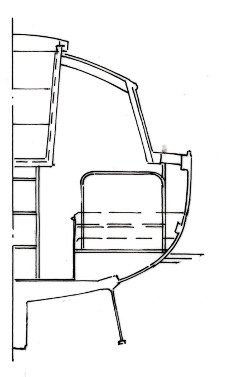
Related Products
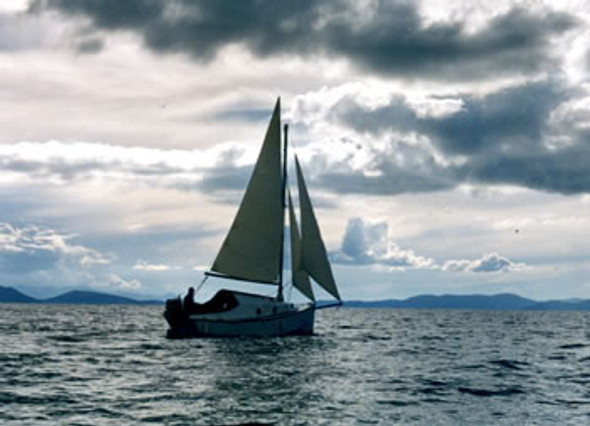
19'6" White Swan Plans

Highlander 19'6" Plans
Heron 15 pocket cruiser plans.

SCAMP CNC PLYWOOD KIT


My Cruiser Life Magazine
Basics of Sailboat Hull Design – EXPLAINED For Owners
There are a lot of different sailboats in the world. In fact, they’ve been making sailboats for thousands of years. And over that time, mankind and naval architects (okay, mostly the naval architects!) have learned a thing or two.
If you’re wondering what makes one sailboat different from another, consider this article a primer. It certainly doesn’t contain everything you’d need to know to build a sailboat, but it gives the novice boater some ideas of what goes on behind the curtain. It will also provide some tips to help you compare different boats on the water, and hopefully, it will guide you towards the sort of boat you could call home one day.
Table of Contents
Displacement hulls, semi displacement hulls, planing hulls, history of sailboat hull design, greater waterline length, distinctive hull shape and fin keel designs, ratios in hull design, the hull truth and nothing but the truth, sail boat hull design faqs.

Basics of Hull Design
When you think about a sailboat hull and how it is built, you might start thinking about the shape of a keel. This has certainly spurred a lot of different designs over the years, but the hull of a sailboat today is designed almost independently of the keel.
In fact, if you look at a particular make and model of sailboat, you’ll notice that the makers often offer it with a variety of keel options. For example, this new Jeanneau Sun Odyssey comes with either a full fin bulb keel, shallow draft bulb fin, or very shallow draft swing keel. Where older long keel designs had the keel included in the hull mold, today’s bolt-on fin keel designs allow the manufacturers more leeway in customizing a yacht to your specifications.
What you’re left with is a hull, and boat hulls take three basic forms.
- Displacement hull
- Semi-displacement hulls
- Planing hulls
Most times, the hull of a sailboat will be a displacement hull. To float, a boat must displace a volume of water equal in weight to that of the yacht. This is Archimedes Principle , and it’s how displacement hulled boats get their name.
The displacement hull sailboat has dominated the Maritimes for thousands of years. It has only been in the last century that other designs have caught on, thanks to advances in engine technologies. In short, sailboats and sail-powered ships are nearly always displacement cruisers because they lack the power to do anything else.
A displacement hull rides low in the water and continuously displaces its weight in water. That means that all of that water must be pushed out of the vessel’s way, and this creates some operating limitations. As it pushes the water, water is built up ahead of the boat in a bow wave. This wave creates a trough along the side of the boat, and the wave goes up again at the stern. The distance between the two waves is a limiting factor because the wave trough between them creates a suction.
This suction pulls the boat down and creates drag as the vessel moves through the water. So in effect, no matter how much power is applied to a displacement hulled vessel, it cannot go faster than a certain speed. That speed is referred to as the hull speed, and it’s a factor of a boat’s length and width.
For an average 38 foot sailboat, the hull speed is around 8.3 knots. This is why shipping companies competed to have the fastest ship for many years by building larger and larger ships.
While they might sound old-school and boring, displacement hulls are very efficient because they require very little power—and therefore very little fuel—to get them up to hull speed. This is one reason enormous container ships operate so efficiently.
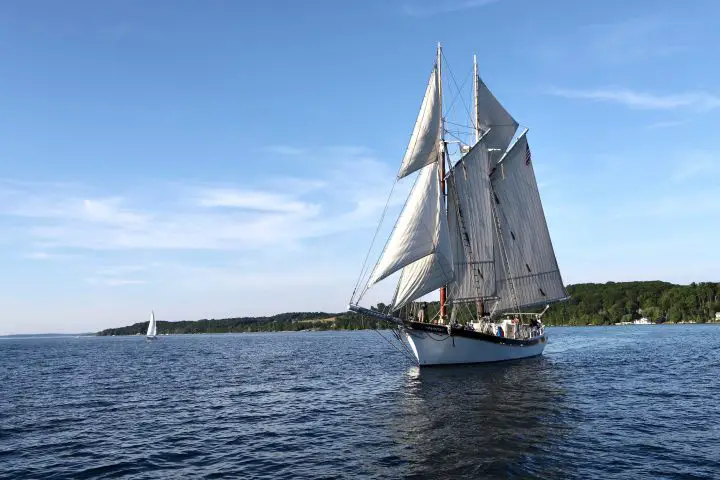
Of course, living in the 21st century, you undoubtedly have seen boats go faster than their hull speed. Going faster is simply a matter of defeating the bow wave in one way or another.
One way is to build the boat so that it can step up onto and ride the bow wave like a surfer. This is basically what a semi-displacement hull does. With enough power, this type of boat can surf its bow wave, break the suction it creates and beat its displacement hull speed.
With even more power, a boat can leave its bow wave in the dust and zoom past it. This requires the boat’s bottom to channel water away and sit on the surface. Once it is out of the water, any speed is achievable with enough power.
But it takes enormous amounts of power to get a boat on plane, so planing hulls are hardly efficient. But they are fast. Speedboats are planing hulls, so if you require speed, go ahead and research the cost of a speedboat .
The most stable and forgiving planing hull designs have a deep v hull. A very shallow draft, flat bottomed boat can plane too, but it provides an unforgiving and rough ride in any sort of chop.
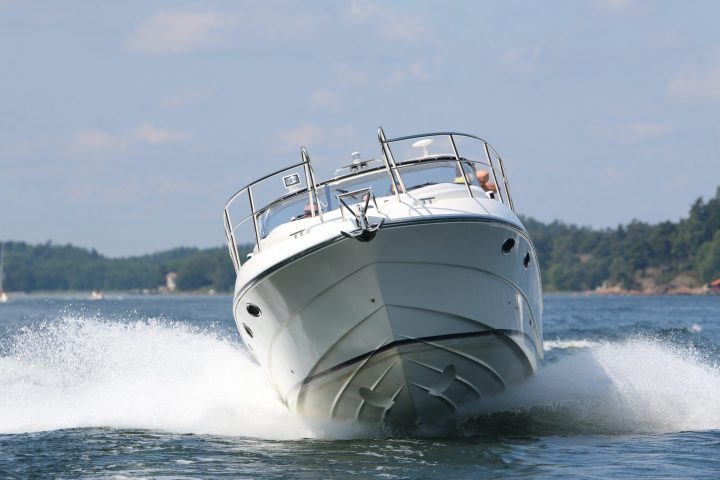
If you compare the shapes of the sailboats of today with the cruising boat designs of the 1960s and 70s, you’ll notice that quite a lot has changed in the last 50-plus years. Of course, the old designs are still popular among sailors, but it’s not easy to find a boat like that being built today.
Today’s boats are sleeker. They have wide transoms and flat bottoms. They’re more likely to support fin keels and spade rudders. Rigs have also changed, with the fractional sloop being the preferred setup for most modern production boats.
Why have boats changed so much? And why did boats look so different back then?
One reason was the racing standards of the day. Boats in the 1960s were built to the IOR (International Offshore Rule). Since many owners raced their boats, the IOR handicaps standardized things to make fair play between different makes and models on the racecourse.
The IOR rule book was dense and complicated. But as manufacturers started building yachts, or as they looked at the competition and tried to do better, they all took a basic form. The IOR rule wasn’t the only one around . There were also the Universal Rule, International Rule, Yacht Racing Association Rul, Bermuda Rule, and a slew of others.
Part of this similarity was the rule, and part of it was simply the collective knowledge and tradition of yacht building. But at that time, there was much less distance between the yachts you could buy from the manufacturers and those setting off on long-distance races.
Today, those wishing to compete in serious racing a building boat’s purpose-built for the task. As a result, one-design racing is now more popular. And similarly, pleasure boats designed for leisurely coastal and offshore hops are likewise built for the task at hand. No longer are the lines blurred between the two, and no longer are one set of sailors “making do” with the requirements set by the other set.
Modern Features of Sailboat Hull Design
So, what exactly sets today’s cruising and liveaboard boats apart from those built-in decades past?
Today’s designs usually feature plumb bows and the maximum beam carried to the aft end. The broad transom allows for a walk-through swim platform and sometimes even storage for the dinghy in a “garage.”
The other significant advantage of this layout is that it maximizes waterline length, which makes a faster boat. Unfortunately, while the boats of yesteryear might have had lovely graceful overhangs, their waterline lengths are generally no match for newer boats.
The wide beam carried aft also provides an enormous amount of living space. The surface area of modern cockpits is nothing short of astounding when it comes to living and entertaining.
If you look at the hull lines or can catch a glimpse of these boats out of the water, you’ll notice their underwater profiles are radically different too. It’s hard to find a full keel design boat today. Instead, fin keels dominate, along with high aspect ratio spade rudders.
The flat bottom boats of today mean a more stable boat that rides flatter. These boats can really move without heeling over like past designs. Additionally, their designs make it possible in some cases for these boats to surf their bow waves, meaning that with enough power, they can easily achieve and sometimes exceed—at least for short bursts—their hull speeds. Many of these features have been found on race boats for decades.
There are downsides to these designs, of course. The flat bottom boats often tend to pound when sailing upwind , but most sailors like the extra speed when heading downwind.
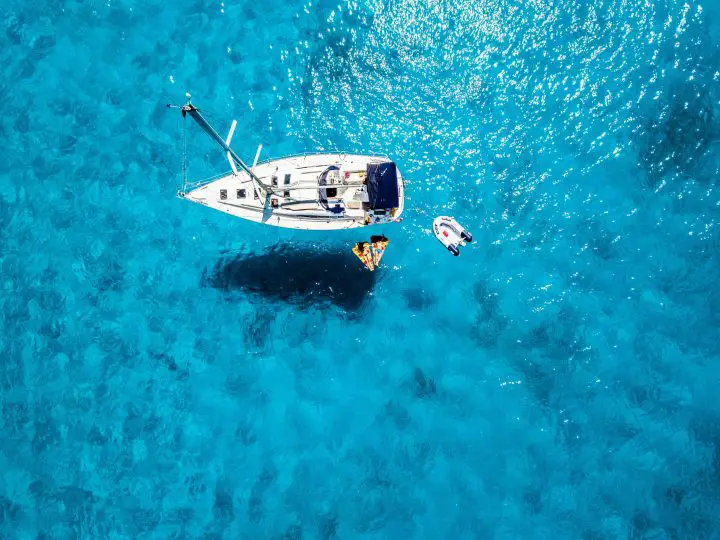
How Do You Make a Stable Hull
Ultimately, the job of a sailboat hull is to keep the boat afloat and create stability. These are the fundamentals of a seaworthy vessel.
There are two types of stability that a design addresses . The first is the initial stability, which is how resistant to heeling the design is. For example, compare a classic, narrow-beamed monohull and a wide catamaran for a moment. The monohull has very little initial stability because it heels over in even light winds. That doesn’t mean it tips over, but it is relatively easy to make heel.
A catamaran, on the other hand, has very high initial stability. It resists the heel and remains level. Designers call this type of stability form stability.
There is also secondary stability, or ultimate stability. This is how resistant the boat is to a total capsize. Monohull sailboats have an immense amount of ballast low in their keels, which means they have very high ultimate stability. A narrow monohull has low form stability but very high ultimate stability. A sailor would likely describe this boat as “tender,” but they would never doubt its ability to right itself after a knock-down or capsize.
On the other hand, the catamaran has extremely high form stability, but once the boat heels, it has little ultimate stability. In other words, beyond a certain point, there is nothing to prevent it from capsizing.
Both catamarans and modern monohulls’ hull shapes use their beams to reduce the amount of ballast and weight . A lighter boat can sail fast, but to make it more stable, naval architects increase the beam to increase the form stability.
If you’d like to know more about how stable a hull is, you’ll want to learn about the Gz Curve , which is the mathematical calculation you can make based on a hull’s form and ultimate stabilities.
How does a lowly sailor make heads or tails out of this? You don’t have to be a naval architect when comparing different designs to understand the basics. Two ratios can help you predict how stable a design will be .
The first is the displacement to length ratio . The formula to calculate it is D / (0.01L)^3 , where D is displacement in tons and L is waterline length in feet. But most sailboat specifications, like those found on sailboatdata.com , list the D/L Ratio.
This ratio helps understand how heavy a boat is for its length. Heavier boats must move more water to make way, so a heavy boat is more likely to be slower. But, for the ocean-going cruiser, a heavy boat means a stable boat that requires much force to jostle or toss about. A light displacement boat might pound in a seaway, and a heavy one is likely to provide a softer ride.
The second ratio of interest is the sail area to displacement ratio. To calculate, take SA / (D)^0.67 , where SA is the sail area in square feet and D is displacement in cubic feet. Again, many online sites provide the ratio calculated for specific makes and models.
This ratio tells you how much power a boat has. A lower ratio means that the boat doesn’t have much power to move its weight, while a bigger number means it has more “get up and go.” Of course, if you really want to sail fast, you’d want the boat to have a low displacement/length and a high sail area/displacement.
Multihull Sailboat Hulls
Multihull sailboats are more popular than ever before. While many people quote catamaran speed as their primary interest, the fact is that multihulls have a lot to offer cruising and traveling boaters. These vessels are not limited to coastal cruising, as was once believed. Most sizable cats and trimarans are ocean certified.
Both catamarans and trimaran hull designs allow for fast sailing. Their wide beam allows them to sail flat while having extreme form stability.
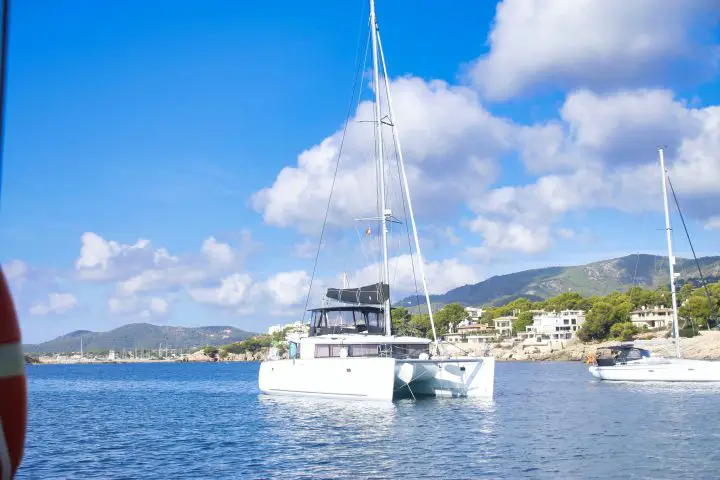
Catamarans have two hulls connected by a large bridge deck. The best part for cruisers is that their big surface area is full of living space. The bridge deck usually features large, open cockpits with connecting salons. Wrap around windows let in tons of light and fresh air.
Trimarans are basically monohulls with an outrigger hull on each side. Their designs are generally less spacious than catamarans, but they sail even faster. In addition, the outer hulls eliminate the need for heavy ballast, significantly reducing the wetted area of the hulls.
Boaters and cruising sailors don’t need to be experts in yacht design, but having a rough understanding of the basics can help you pick the right boat. Boat design is a series of compromises, and knowing the ones that designers and builders take will help you understand what the boat is for and how it should be used.
What is the most efficient boat hull design?
The most efficient hull design is the displacement hull. This type of boat sits low in the water and pushes the water out of its way. It is limited to its designed hull speed, a factor of its length. But cruising at hull speed or less requires very little energy and can be done very efficiently.
By way of example, most sailboats have very small engines. A typical 40-foot sailboat has a 50 horsepower motor that burns around one gallon of diesel every hour. In contrast, a 40-foot planing speedboat may have 1,000 horsepower (or more). Its multiple motors would likely be consuming more than 100 gallons per hour (or more). Using these rough numbers, the sailboat achieves about 8 miles per gallon, while the speedboat gets around 2 mpg.
What are sail boat hulls made of?
Nearly all modern sailboats are made of fiberglass.
Traditionally, boats were made of wood, and many traditional vessels still are today. There are also metal boats made of steel or aluminum, but these designs are less common. Metal boats are more common in expedition yachts or those used in high-latitude sailing.
Matt has been boating around Florida for over 25 years in everything from small powerboats to large cruising catamarans. He currently lives aboard a 38-foot Cabo Rico sailboat with his wife Lucy and adventure dog Chelsea. Together, they cruise between winters in The Bahamas and summers in the Chesapeake Bay.
The Top Sailboat Manufacturers (According to Sailors)
Whether you are buying or chartering a boat, or whether you simply want to stay informed, you might be asking the question: who are the top sailboat manufacturers? As is the case with most 'who's the best' questions, the answer isn't simple. So this article takes a stroll among the crowds and asks - “who's your favorite?” .
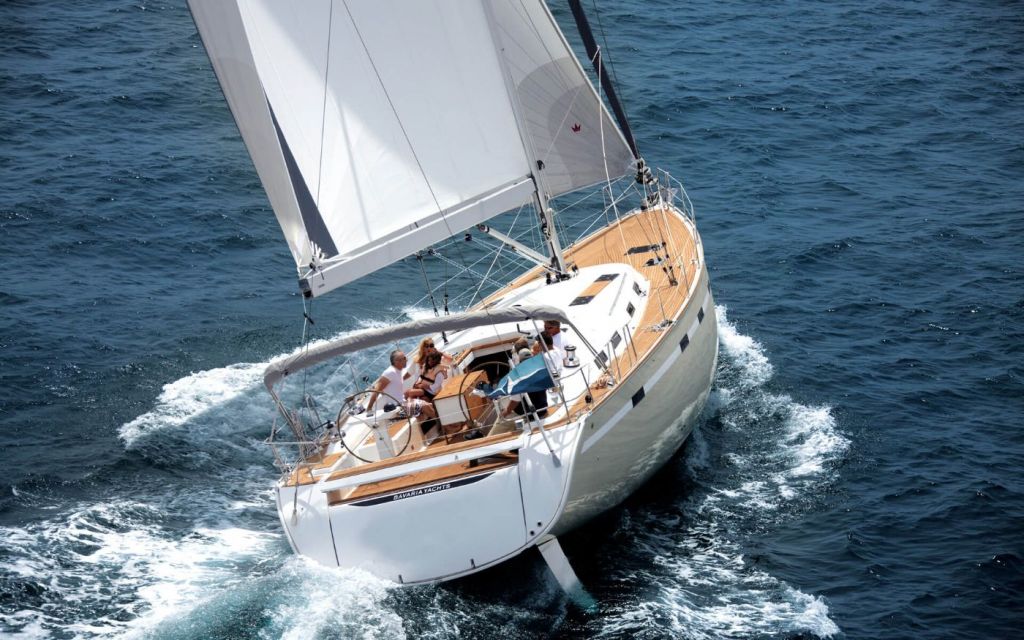
What are the top sailboat manufacturers?
Groupe beneteau.
This is the ultimate all-star list. Now let’s see why.
First of all - I want to make this lineup relatively short. There are tens of names that bounce around when you ask about favorite manufacturers, and if I had made this a long list, in the end, it wouldn’t represent the famous all-stars that really stand out in the eyes of the people. If you want a longer, less detailed list, check out our article about 50 popular sailboat brands . This time though, we are looking only at the manufacturer champions of the ‘popular choice’ contest.
“This is a loaded question!”, the internet forums yell, “there are thousands of options!”, they cry, enraged, “it’s not about the boat, but about the crew!” they scream. But we don’t give up and continue, determined to find out who you all like the most.
Cover Image : Bavaria Cruiser 55 - Copyright BavariaYachtbau under CC BY-SA 4.0
I know, I know, I hear you. Let’s start with the cons of these boats to quench the thirst of the bloodthirsty critics. Yes, Wallys are very costly, they go all the way up to tens of millions of dollars and so won’t be more than a bedroom poster for most of the readers.
That’s about it when it comes to the negatives, though. The reason they made it on this list despite their price tag is that they are pioneers in many aspects. Visually they are beyond gorgeous, and their price allows for exquisite build quality. The cost of these hi-end racer/cruisers means they aren’t particularly user friendly since most users won’t be able to use them, but just as Rolls Royce belongs on the list of the best cars, Wally belongs on the list of the best boats. They are the brainchild of Luca Bassani, founder and chief of the brand, a stylish Italian man who knows what’s right.
And it is this poster worthiness that gained them popularity among the crowds. A video of a simple Atlantic crossing on a 100 foot Wally has millions of views not necessarily because that particular journey would be exciting, in fact, it is quite an uneventful one, but because it is on a boat that makes the design junkies salivate. The Wally designs alone were the reason these boats made it into Hollywood feature films and series, and if you look at one, you’ll understand why. This is what happens when extravaganza meets good taste and has all the money in the world to realize the idea.
What do they make in terms of sailboats? Superyachts around 100 ft long, each focused on sporty cruising, design, and comfort. They only make custom sailboats, no factory models here. Buying a used one is a safe situation, they hold up even after a long time both in terms of quality, performance as well as design. During their existence, Wally only made a handful of boats, so if you ever stumble upon one, take a selfie. It is like meeting a celebrity.
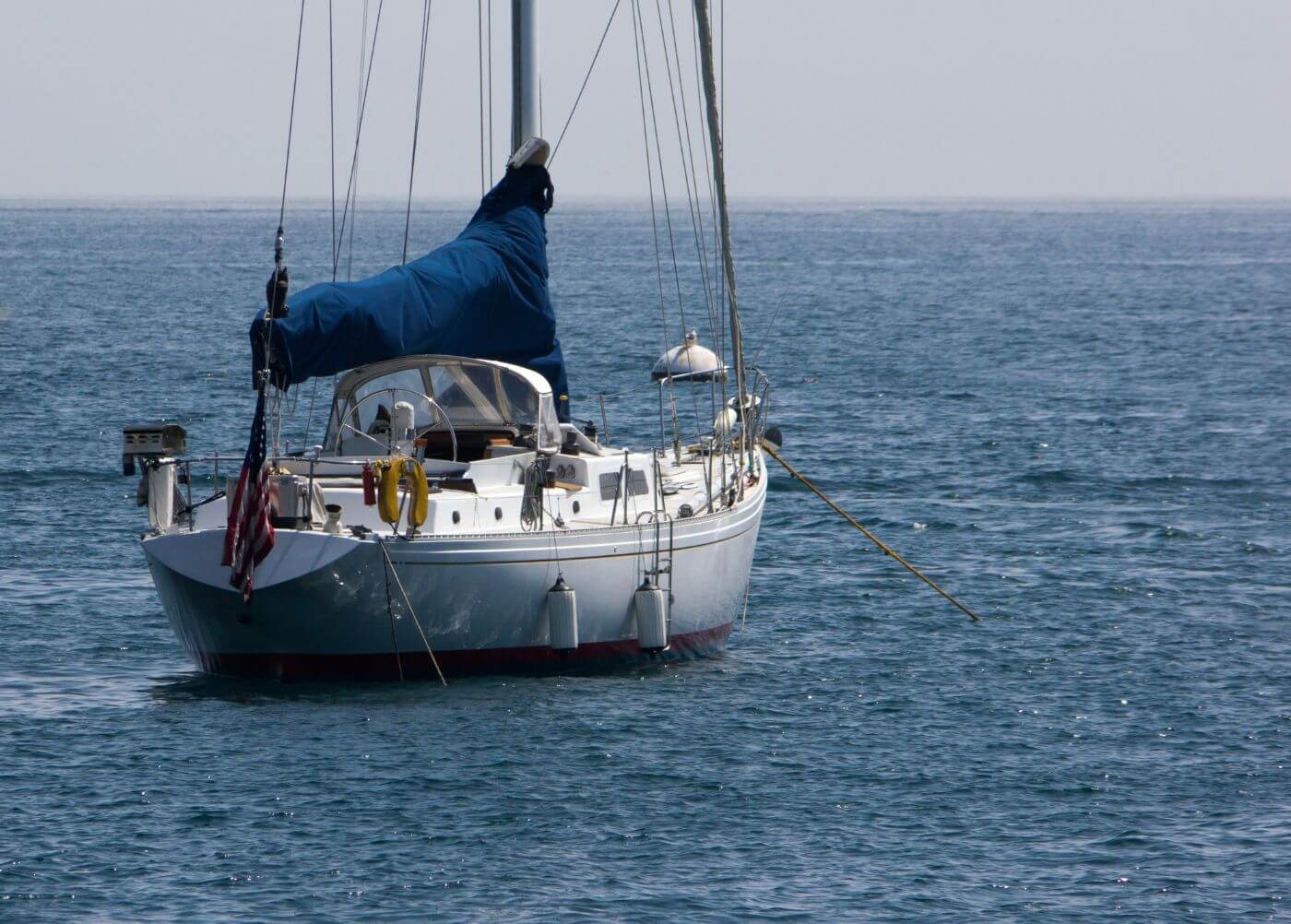
To level the scales, let’s now jump at the opposite side of the spectrum and have a look at Catalina, the people pleaser. If Wally was the Rolls Royce of the boating world, Catalina is the Ford, making, as they say, “honest, sturdy boats that hold up to real-world conditions, perform well and cost less to maintain”. The mission of this company then seems to be to make boats as practical as possible for the common folk. That means: a practical interior layout, practical handling, and last but definitely not least, a practical price.
And this strategy has worked out well - according to experiences of hundreds of thousands of sailors, Catalinas stand up to their reputation of a boat that’s got your back. It is one of the largest boat producers in the world, with over sixty thousand of its boats sailing the world. Boat manufacturers oftentimes go through quite a lot of rough patches, that turn into bankruptcy for many, it isn’t an easy business to be in, but Catalina has been on a roll for decades. And this success has come with its perks - the business stability allowed for some impressive manufacturing facilities, which helps mass production, which in turn helps drive the price down. So with Catalina, you’ll likely be getting more bang for your buck than from their competition.
They make boats ranging from tiny daysailers all the way to 50-foot seaworthy vessels. What made them the most famous though are their mid-sized cruisers - the staple of the classical American sailing fan. Whether you like it or not, slow and steady is the name of the game when it comes to mainstream, and that is precisely what Catalina understands so well. They don’t take large risks. Their models are long-running with slight tweaks and facelifts, concepts that don’t surprise or insult, but offer stability. This conservativeness has been what some sailors hold against Catalinas, which is easy to understand when looking at many other brands that offer more in terms of fanciness, but this is the Catalina way, and it has worked out splendidly for them.
The long years of experience make for a great manufacturer that makes boats which won’t be the fastest, won’t be the prettiest or the boldest in terms of design or technological innovation, but they will do precisely what they are made to do - their job.
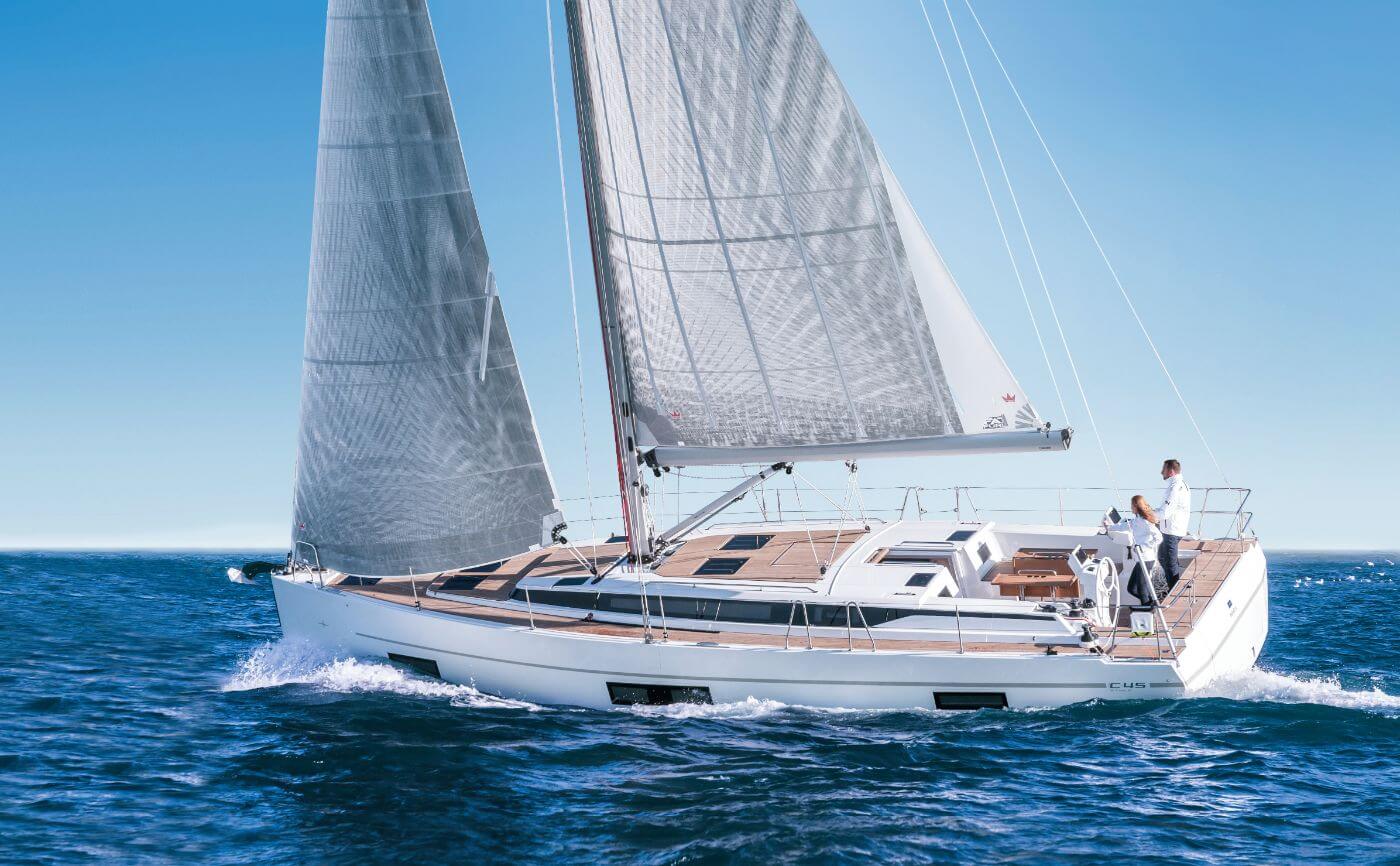
Bavaria is to Europe what Catalina is to the United States. Affordable, practical, nothing special, but does what it’s supposed to. It is the main diet of many Mediterranean sailors. To stay with the cars equivalent, just because I like it so much, if Catalinas were the Ford, Bavarias would be the Volkswagen. They are generally cheaper than Catalinas but don’t see that as an indicator, sailors can’t seem to find one or the other significantly worse or better in build quality. There are of course a few voices rooting for one or the other, but that can be assigned to fandom rather than to actual benefits. The price difference is there partly due to a different manufacturing process, the Bavaria factories are more efficient (they are German after all), and the production is more streamlined, allowing cutting costs without cutting corners.
Reliability, ease of use, and affordability are aspects that lead the design decisions here - which is what makes them so prevalent in charter companies. Even a nonexperienced sailor can get on a Bavaria and operate it with relative ease. But as I’ve been told by the boss of an unnamed charter company, after five or so years, you will start to feel the lower price tag as their reliability starts to go down unless money is put into repairs. With an older Bavaria, you will feel its age more than with other manufacturers. As one owner puts it, they tend to get “quite exhausted”.
So in case you belong among the Bavaria fans and have your eye on a used one, keep the above sentences in mind and when shopping, make sure you understand the ‘health’ of the boat in question. Moreover, be aware of the difference between a boat that was used by a handful of sailors over the years versus one that was chartered to more people than you could count. In other words, you wouldn’t want to buy a few-year-old rental car because who knows what the poor thing had to suffer, - especially since you can bet that many of the clients weren’t particularly good sailors due to generous sailing license policies in Croatia, which allows virtually anybody to ‘become a sailor’ within hours for a friendly fee.
What can you expect when you get on one? Good things - the manufacturers know what their products are used for, and that is why Bavarias are designed as easy comfortable cruisers. Everything you need to have within reach will be within reach, to the point of you having something to hold on almost all the time wherever you go through the boat - Bavaria knows well that many of its users won’t have their ‘sea legs’ and act accordingly. Even smaller models have generous amounts of space because it is the smaller models that are charter kings - Bavaria gives a lot of attention to them. The layouts will be comfy, so Bavarias make good boats for longer voyages - pair that with reliability and price and you will understand why the vox populi speaks so fondly of them.
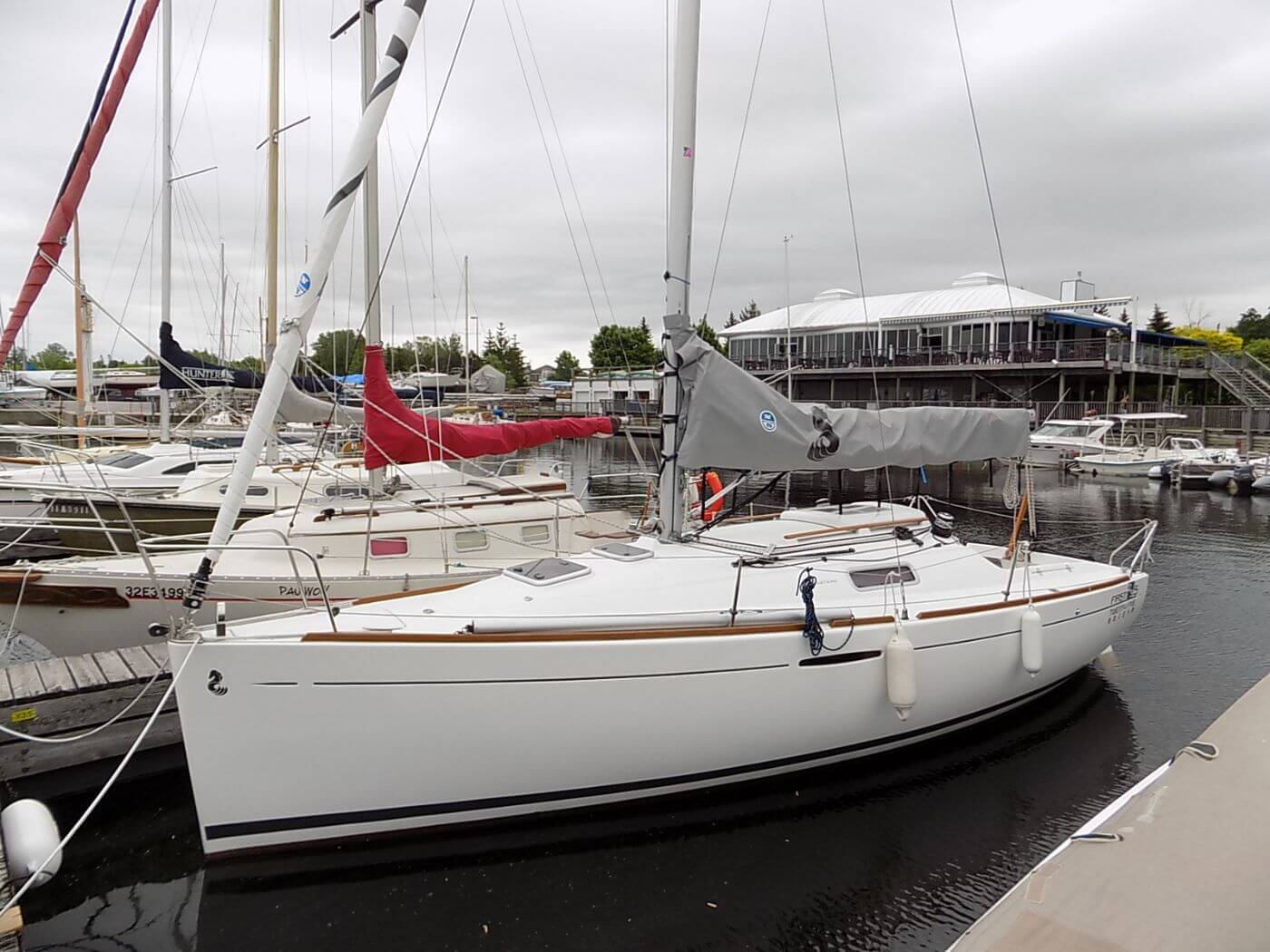
The reason I am mentioning the name of the parent company here is that they own both Beneteau and Jeanneau, brands that are distinguishable on the surface, but if you look close enough, you will find them pretty similar, down to the fact that they are produced in the same factory. So since both Beneteau and Jeanneau are very popular sailor’s choices, both deserve a place on this list, but dedicating a subchapter to each would feel like making a duplicate.
By the way, Groupe Beneteau also owns Lagoon, a renowned catamaran maker, Prestige, luxury yacht manufacturer, Monte Carlo Yachts, CNB Yacht builder, the semi-custom sailboat maker, Four Winns, Glastron, Scarab, Wellcraft, Excess, and Delphia… some of these make motor yachts only, but if you combine fans of all of these, you get a sizable crowd. This company has figured out what people of various tastes want and serves quite a few of these niches.
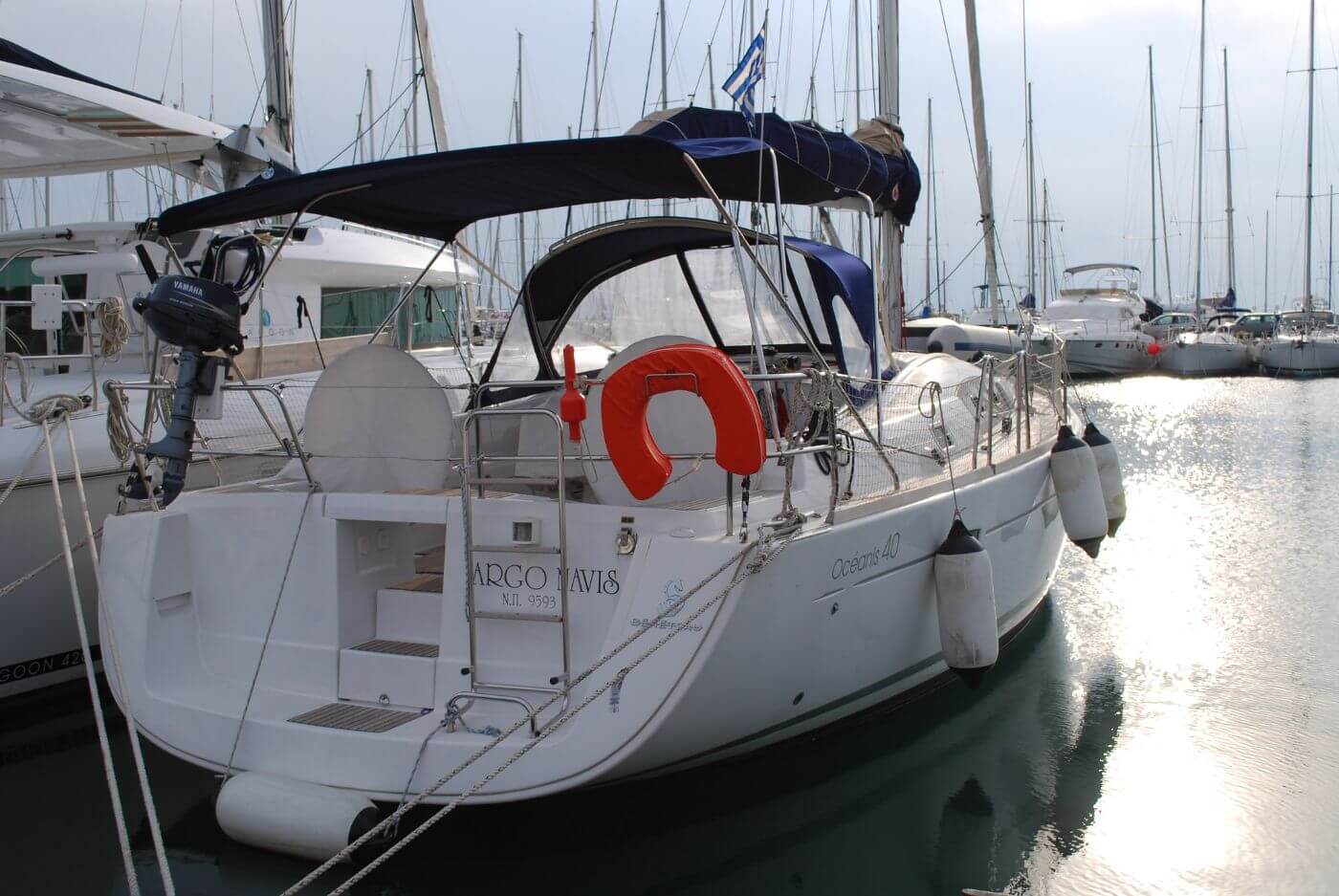
Business aside, let’s see how this French company managed to find its way into the hearts of so many. Well, first of all, they are French. So chic style is to be expected. And with this, fans come. Image wise (and design-wise to a bit) Jeanneau is the sporty one that sails better, while Beneteau aims at the family comfort market. But on both, you will feel loved by the designer. They are made to make you feel good when you use them, and they’ll spoil you with luxury that fits within the specific price tag.
Comfort is a big deal here. On Jeanneaus for instance, you will sometimes find quite unique layouts, often different from the traditional ones, to really pamper the sailors - such as their two master bedroom setup, with the stern one being under the cockpit. A lot of them come with the 360 docking system, which allows you to move the boat around with a joystick and makes maneuvering in marinas so easy you feel like you are cheating. Or consider their decision to make the hull finer to cut through the water better, resulting in less movement - something that helps with comfort. All of this comes for a price but less so than you would expect since the buying power of the enormous Groupe Beneteau helps with shaving off dollars where smaller manufacturers couldn’t. This is, for instance, the reason why they can afford to use wood on their crafts to an extent you wouldn’t expect from a production boat for that price - again, buying volume allows for this even without you necessarily having to pay the expected premium.
Of course, you will mostly find them in Europe, where they are plentiful in marinas, though the aforementioned Bavarias dominate as far as numbers go. But that is mostly because of charters, since last year, over 80 percent of chartered boats were Bavarias. As personal boats, products of Groupe Beneteau belong among the top choices.
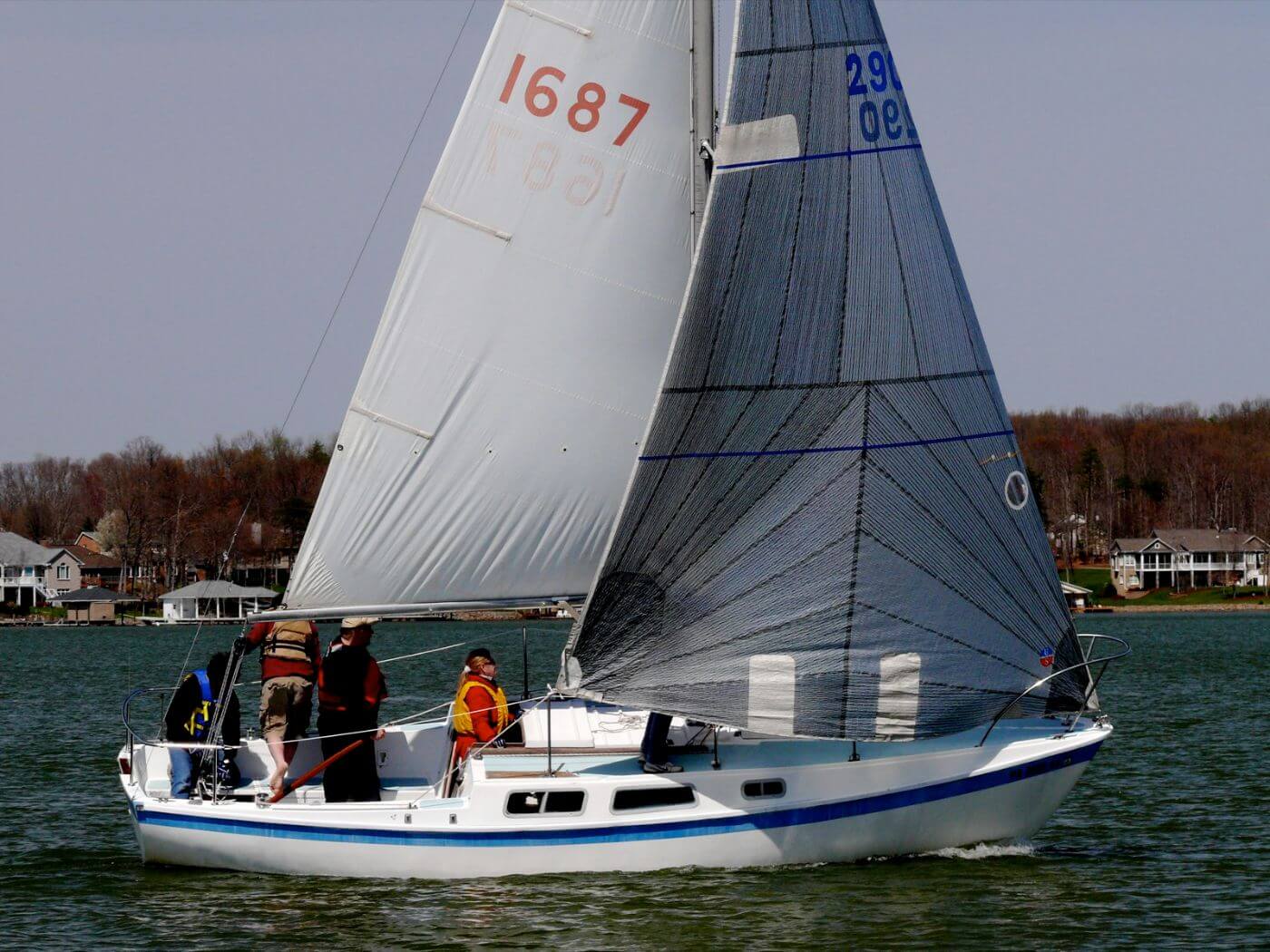
Now, this is a bit of a tricky one. The manufacturer doesn’t exist anymore, in fact, it produced boats from 1960 to 1989, making it over thirty years old, but despite that, the Cal models are still a favorite and worthy member of the cruising as well as performance world.
During the company’s existence, almost twenty thousand boats were built, partially because they were one of the first brands to mass-produce fiberglass sailboats. That, along with Cal models winning impressively in races, helped them to make a name for themselves, a name that still sounds to this day.
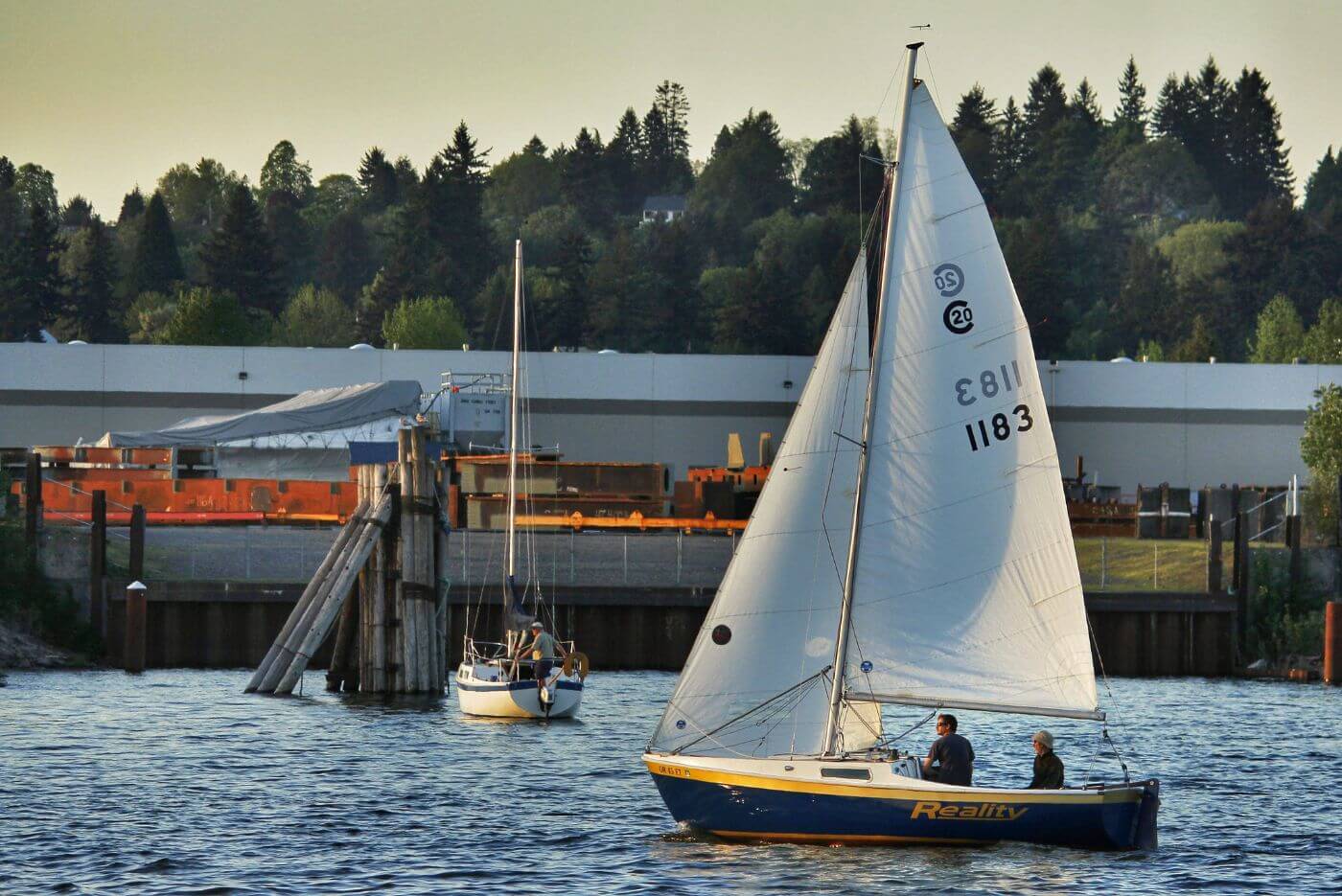
Why is it on this list? Partially because of its prevalence on the seas, partially because of its prevalence in internet forums and pub talks. Cal sailboats are loved by their owners mostly for their responsiveness when under sail, good build quality, (even though many say the interior could have been done way better) as well as reliability even after long years of use. Many of the design features have indeed been improved since, so if thirty years ago you could dominate races with Cals, today you won’t be on the lightest and most up to date boat around anymore. But you won’t be sailing a cruiser either. The boat might not be a pureblood racer, but it was built with racing in mind. Which might give the more sporty ones of your peace of mind that no Bavaria or any traditional cruiser will provide.
Quite a few owners say though that the success from the sixties gained Cal a name that you will pay for when buying one. If you are one of those who want to make sure they are paying for physical value rather than reputation, this might be a dealbreaker for you. There is a certain portion of slight arrogance that comes with racing success, one that shows in later models. But given the brand’s popularity, this is not too big of a deal.
So if cruising is your goal, if long crossings are what you desire, if you simply want a boat that was built with honesty and can take you basically anywhere you want, Cals are a safe bet. You’ll be joining a big, happy and an old family. And an affordable one at that.
In conclusion
To sum it all up, it seems that practicality, affordability, and reliability are the main factors that influence whether a sailboat manufacturer will become popular among sailors or not. As well as extravagant design and beauty, but that’s another story.
There have been many shipyards throughout the ages, some long-lasting, some surviving but a couple of years. Each tried to come up with an angle to sell well. Sometimes it was quirky design, and sometimes it was an intriguing feature, sometimes it was the use of new technology. Sometimes it worked out quite well, other times it did not. But in the end what sailors seem to want is a boat that will not fail them when they need it the most, a boat that is well built enough to cross oceans, because that gives one a sense of freedom and a boat that is built with the user-friendliness in mind. Simply, a boat that is your good friend.
A road to a sailor’s heart is simple, after all.
Daniel O'Connell
Really good article. I was enlightened.
Dan O’Connell
Leave a comment
Own your first boat within a year on any budget.
A sailboat doesn't have to be expensive if you know what you're doing. If you want to learn how to make your sailing dream reality within a year, leave your email and I'll send you free updates . I don't like spam - I will only send helpful content.
Ready to Own Your First Boat?
Just tell us the best email address to send your tips to:

- My Wishlist
- United States
- Sets by theme
- Price Ranges
- LEGO Merchandise
- Pick and Build
- Bestsellers
- Offers & Sale
- Coming Soon
- Find inspiration
- Last Chance to Buy
- Architecture
- Botanical Collection New
- Creator 3in1
- Creator Expert
- Harry Potter™
- Jurassic World
- LEGO® Animal Crossing™ New
- LEGO® Avatar
- LEGO® Braille Bricks New
- LEGO® DREAMZzz™
- LEGO® DUPLO® Peppa Pig New
- LEGO® Education
- LEGO® Gabby's Dollhouse
- LEGO® Icons
- LEGO® Indiana Jones™
- LEGO® Super Mario™
- Lord of the Rings™
- Minifigures
- Monkie Kid™
- SERIOUS PLAY®
- Sonic the Hedgehog™
- Speed Champions
- Star Wars ™
- Accessories
- LEGO® Throw Blankets New
- Lunch Boxes
- Puzzles & Board games
- Role Play & Costumes
- Video Games
- LEGO® Water Bottles
- Adults Welcome
- Arts and Crafts
- Coding for Kids
- Learn to build
- Real-Life Heroes
- Robots for Kids
- Pick a Brick
- Brick Accessories & Kits
- Minifigure Factory
- Our Magazines
- Black Friday Livestream
- All LEGO Themes
- All LEGO Interests
- Looking For a Gift?
- For Families
- LEGO® Fortnite®
- LEGO® Insiders
- LEGO® Mosaic Maker
- LEGO® Gift Ideas
- Sustainability
- LEGO Builder
- LEGO Life App
- LEGO Catalogs
- FREE LEGO Life Magazine
- Check Order Status
- Delivery & Returns
- Find a LEGO Store
- Find Building Instructions
- Common Questions
- Replacement Parts
Spring Garden House gift with purchases of $80 or more* Learn more
Sweet bunny gift with purchases of $40 or more* Learn more
FREE Shipping with orders over $35!* Learn more
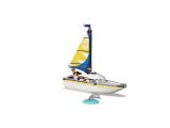
Available now
We restrict the limit a household can buy in order to be fair to all of our fans. If you’ve already reached that limit through previous orders your entire order may be cancelled.
Become a LEGO® Insider!
Time to set sail, a fun build-and-sail toy for ages 5+, lego® city sailboat, elegant design.
Check out the tall mast and printed sail.
Welcome aboard
Includes a boat’s wheel and a cozy cabin with a bed.
Characters for creative play
Fun adventures with 2 minifigures and a dolphin figure.
Enter a digital world of building
A treat for sailing fans, specifications, customer reviews.

IMAGES
VIDEO
COMMENTS
Top 10 Affordable Sailboats Anyone Can Build at Home. Building your own pocket cruiser or other styles from boat plans is an impressive feat, as this will need dedicated time and money to assure your boat sails safely. Boat building takes a lot of patience as well, especially since this will not be completed in a fast manner.
For example, the 21ft gaff-rigged cutter I'm currently building will end up costing between $33,000 and $35,000, fully outfitted—several thousand dollars more than the new prices of a couple of popular fiberglass boats near the same size. And yes, since it's wood, it will demand more maintenance.
How to Build a Boat: Part 1: The All-Important Preparation. Part 2: How to Build a Boat Hull in Western Red Cedar. Part 3: Sheathing the Hull in Woven Glass Rovings. Part 4: Cutting and Installing the Plywood Bulkheads. Part 5: Building the Interior Structure. Part 6: Constructing the Deck and Coach Roof.
The average price range for building a sailboat from scratch is between $10,000 and $20,000. A self-build kit for a 17' sailboat can be purchased for $2,500, while a sail-away Puur 17 kit can cost between $14,000 and $18,000. ... Building a cruiser can cost between $30,000 and $100,000. Some cruisers may have additional amenities such as a ...
Hartley Boats has the widest range of boat plans for sail boats, power boats, catamarans and trimarans, dinghys and small craft, canoes and kayaks, surfboards and surf skis, vintage power boats, self steering capabilities and trailers. Established in 1938, more than 100,000 boats have now been built by enthusiasts from our plans. All Hartley ...
The sailboat hull can be constructed in a step-by-step process. Here is how you can construct a strong and durable sailboat hull: Step 1. Create the hull mold: Start by building a robust and long-lasting frame that accurately represents the shape and size of the hull. Step 2.
A short overview of the building of Southern Cross, a Matt Layden influenced shoal draft coastal cruising sailboat. I built this boat in my house over the c...
Boat Plans, Patterns and Supplies For the Amateur Boat Builder! Every year, thousands of amateurs much like yourself build their own boats the proven Glen-L way. Many builders save 50% or more over the price of a factory-built boat. It's easier than you might think, and it can be a rewarding experience.
Idea 21 small sailboat plan is the latest development of my family of small plywood & epoxy sailboats plans for homebuilders: it was quite a time since I was thinking of an evolution of her smaller 19 footer sister, so I finally take the decision to publish this new plan. The goals of this plan is simple: add interior volume, simplify the work for homebuilders switching to a complete plywood ...
Check out my Patreon to help support the boat build! - https://www.patreon.com/jackwood25Guten Morgen! After months of building and filming, I'm finally post...
Package Includes latest sail boat plans, SAILBOAT building plan updates & revisions, PLUS direct contact with the designer. ... This modern state of the art design is for those that want a fast cruising sailboat and one that can accommodate the family or a racing crew and is a joy to sail as well as being easy to build in a variety of materials.
A second type of kit is often called a pocket cruiser or micro cruiser. Those kits usually have a deck, a larger wooden mast/boom, some bilge ballast, and standing rigging that can support a larger sail plan; and, it requires a more substantial trailer. Those types of boats cost a few thousand more than the most basic sailboats.
Commander Denys Rayner started building plywood dinghies in the 1950s which morphed into a 22ft pocket cruiser called the Westcoaster. Realising the potential of fibreglass, in 1963 he adapted the design to create the Westerly 22, an affordable cruising boat with bilge keels and a reverse sheer coachroof.
Catalina 16.5. jlodrummer. Catalina Yachts are synonymous with bigger boats but they have some great and smaller boats too such as Catalina 16.5. This is one of the best small sailboats that are ideal for family outings given that it has a big and roomy cockpit, as well as a large storage locker.
Cruising Sailboats; Motor Boats; Sail and Oar Boats; Tenders and Rowing Boats ; Trailerable Cabin Sailboats; Jim Michalak . All Jim Michalak; Paddleboats; ... both are needed to build this boat. If you already have the plans for OZ Goose, you can build the Explorer by also purchasing the... $56.00. Add to Cart. Qty in Cart: 0. Quantity ...
09-30-2003, 05:09 PM. I'll second Scott's suggestion of the Stevenson Pocket Cruiser. If you're going to build in your garage, you need a design that has lots of beam and not so much length. A catboat is the answer. The beam is usually about half the length. You'll get the most boat possible in that space.
Westhaven 32. $ 285.00 - $ 300.00 (USD) Build your own sail boat yatch from 9 feet to 63 feet in length. Fully featured wooden boat plans for home construction in Plywood, Steel and Fibre Glass.
Aluminium or steel long range swing keel cruising yacht. Samoa 28. Light displacement comfortable cruiser-racer. Pop Alu 28. Unlimited ocean aluminium cruising yacht with twin bulb keels. Pop Star 21. Trailerable boat for high performance and versatile day sailing. Pop 20. Cheap and easy to build boat for coastal sailing.
Just two small winches take care of headsail sheeting and swinging the keel plate up. There is enough weight in the keel to ensure the boat is self-righting.Next pick up a pre loved mast and some sails or choose from a variety of mast and sail options to suit your budget and sailing preferences. Your Elliott 22 DS is Fun to Build - Fun to Sail.
When building a wooden sailboat, it is important to pay attention to every step, including the installation of the cabin and interior features. To install these features, follow the following steps: 1. First, measure and cut the materials for the cabin walls, floor, and ceiling. 2.
Strip plank. Major strip wood requirements for hull. 2490' of 5/8" x 1 1/4" (760m of 16 x 30mm) Western Red Cedar. Guidance Use. Estuary, coastal, cross channel. Drawing/Design Package. 10 x A1 drawings + 6 x A4 instruction sheets. Additions and alterations included with the plans. 19'6" Pocket Cruiser Plans.
The first is the displacement to length ratio. The formula to calculate it is D / (0.01L)^3, where D is displacement in tons and L is waterline length in feet. But most sailboat specifications, like those found on sailboatdata.com, list the D/L Ratio. This ratio helps understand how heavy a boat is for its length.
Visually they are beyond gorgeous, and their price allows for exquisite build quality. The cost of these hi-end racer/cruisers means they aren't particularly user friendly since most users won't be able to use them, but just as Rolls Royce belongs on the list of the best cars, Wally belongs on the list of the best boats.
A fun build-and-sail toy for ages 5+ Kids enjoy an immersive building experience before joining the crew for exciting sailing adventures. LEGO® City Sailboat. Elegant design. Check out the tall mast and printed sail. Welcome aboard. Includes a boat's wheel and a cozy cabin with a bed. Characters for creative play. Fun adventures with 2 ...